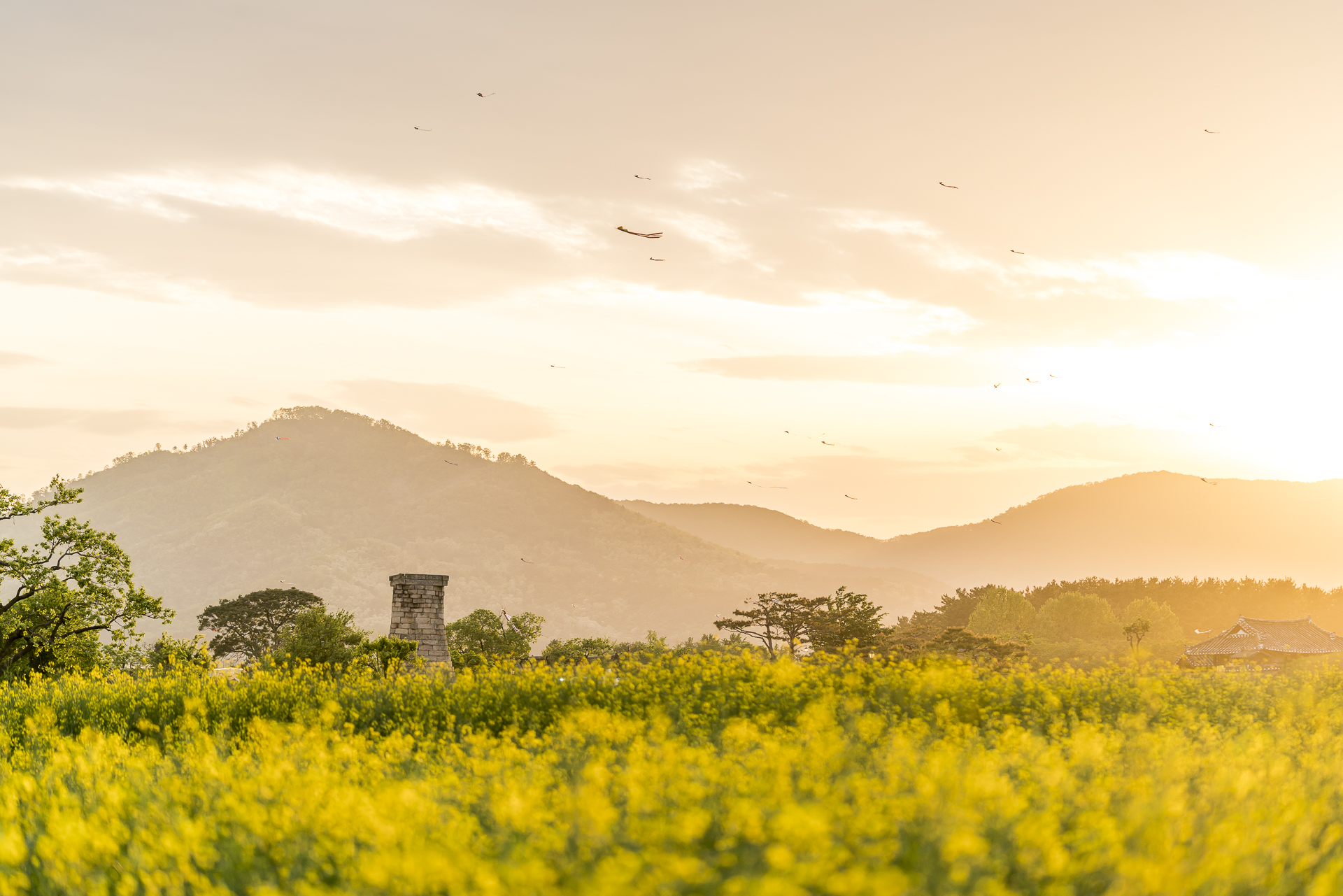
South Korea tour – our itinerary and travel tips
Our South Korea tour was above all a means to an end; With this additional loop, we were able to apply for a double entry visa for the planned trip to China, which entitles us to two entries to China up to six months after the visa issuance date. When applying for the normal Single Entry China visa, there is a three-month deadline, which we could not meet due to our departure date of the big trip. Since South Korea appealed to me as a travel destination anyway, this was the perfect destination to meet the visa requirements.
I boarded the plane in Shanghai without any great expectations or sightseeing preparations. That was good! So South Korea was able to surprise me. The country has succeeded in doing so. The food, the infrastructure and the cultural sights – what a colourful, casual mix.
South Korea Round Trip: Overview of our one-week itinerary
If we hadn’t been required to enter China twice, we would probably have traveled from Japan by ferry to the South Korean port city of Busan. So the journey from Kagoshima first took us to Shanghai for three days and from there with a China Southern flight to Seoul Incheon, the largest international airport in the country. The official name of South Korea is “Republic of Korea” and locally “Korea” is common. In this article, I use the term “South Korea”, which is common in our country, so as not to cause confusion about North Korea.
From Incheon Airport to the city center, there is a direct metro connection (express train or all-stops variant) to Seoul Station as well as various express buses. Since our hotel was close to an express bus station, we decided to take the bus. The bus ticket costs 10,000 won per person, making it more expensive than the “All Stops” metro (4,100 won). As in all big cities, I asked myself the question, where is the best place to stay in Seoul? I chose the centrally located district of Jongno-gu. I had booked 3 nights at the Makers Hotel (affiliate link) there. After intensive sightseeing in Seoul, we started our journey with the Korean express train KTX to Gyeongju. With numerous historical sites from the Silla era, Gyeongju is one of the classic destinations on a South Korea tour. Here we stayed two nights in the charming guesthouse Siwoowadang, in a prime location to explore the sights on foot. Afterwards we went by bus to the second largest city in South Korea – Busan. Again, we planned two nights (TraveLight Hostel) and actually wanted to explore the beautiful cliff landscape. The rainy weather thwarted our plans here and we primarily tried to get our shoes dry. In this respect, two days were too short for Busan. On the seventh day of travel, we took the express train back to Seoul.
In summary, we have chosen the following route for our South Korea round trip: Seoul (3 nights) – Gyeongju (2 nights) – Busan (2 nights).
Sightseeing in Seoul – 3 Days Sightseeing
Seoul may not be quite as big as Tokyo, but it’s also a metropolis that can’t be explored in two or three days. To visit everything extensively and add a day trip to the highly interesting “DMZ” (demilitarized zone between South and North Korea), you need more time. That’s why we deliberately picked out a few highlights in Seoul and focused on “modern” Seoul.
As soon as we arrived at the Makers Hotel (with a well-designed lobby and functionally designed rooms), we walked to Bukchon Hanok Village. Bukchon Hanok Village is known for its traditional Korean-style buildings. It doesn’t really look old, but rather seems “made new on old”. Nevertheless, the winding streets are charming and you will also find one or two nice cafés here. Afterwards, we took a look at one of Seoul’s largest urban development projects in recent years. The Cheonggyecheon River, which was built in the 1940s, was uncovered between 2002 and 2005 and integrated into a six-kilometre-long linear park. We combine our walk along the Cheonggyecheon River with a visit to Gwangjang Market – a mecca for street food lovers. We satisfy our hunger in the restaurant Woolaeoak near the market. The restaurant is known for its cold buckwheat pasta dishes. So well-known that on the first of May (which is also a public holiday here) we stand in line for over an hour. But we are looking forward to the noodles all the more.
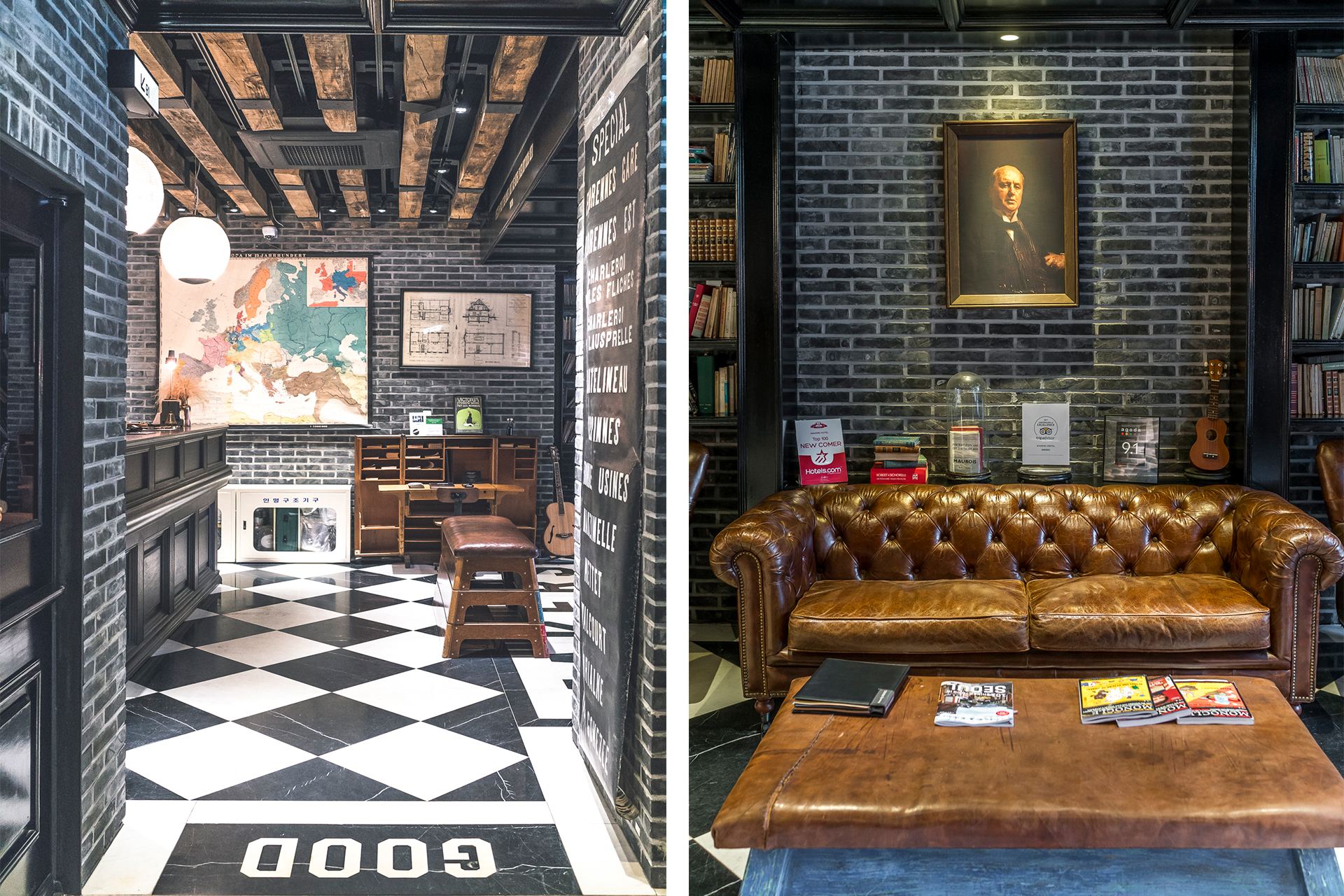
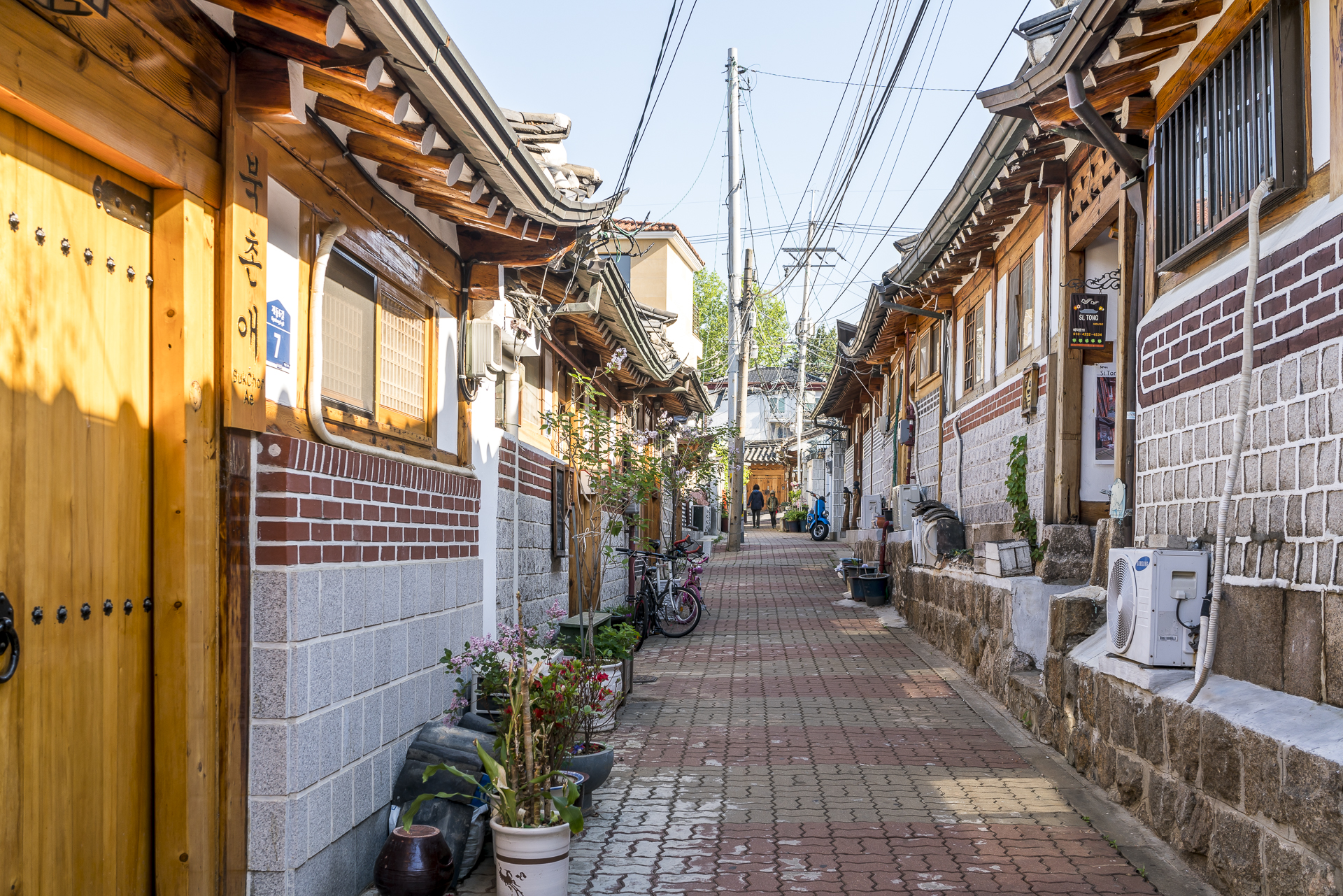
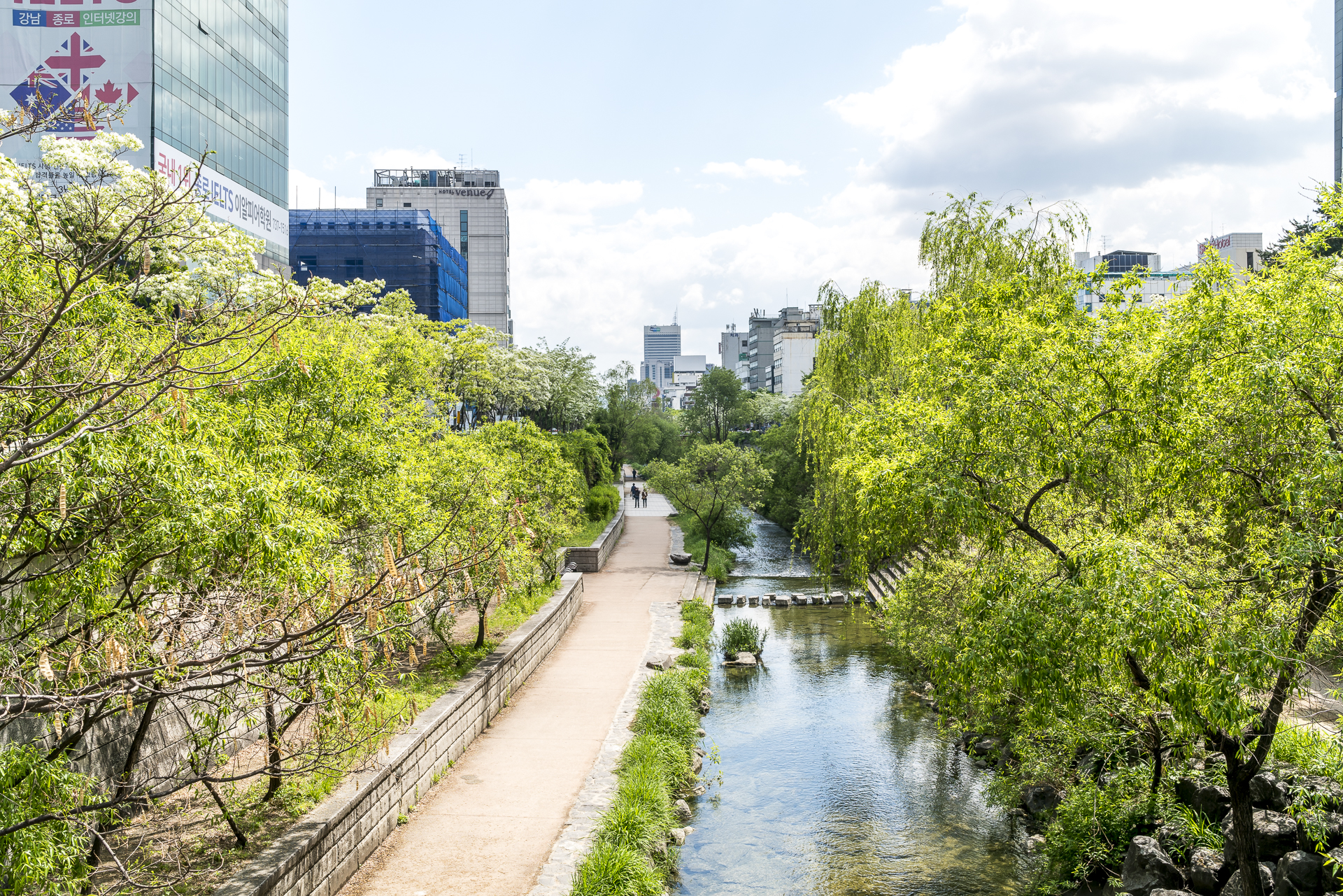
We booked our room at the Makers Hotel without breakfast and start the day looking for an open café. We find what we are looking for in the Terarosa Coffee just around the corner from the Gyeongbokgung palace complex. The café (a Korean chain) is very casually decorated and the coffee tastes good. Strengthened, we head for the palace complex and are glad that the announced rain is still holding back. The entrance fee is 3,000 won per person and the grounds are extensive. While there are numerous school classes in the entrance area and there is a lot going on, the crowds at the back of the facility are steadily decreasing. Correlatedly, my enthusiasm increases. Such bright colors and filigree details!

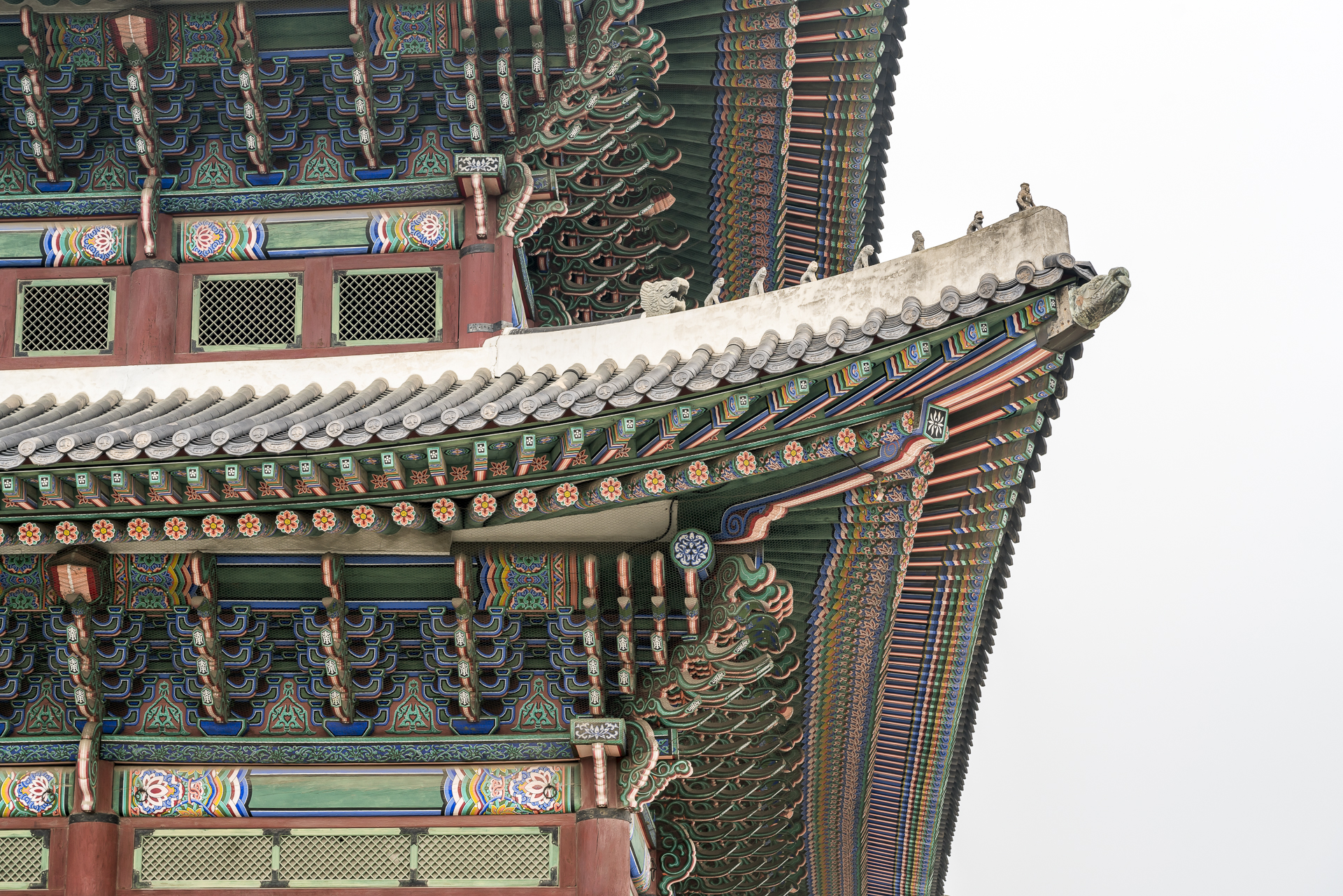
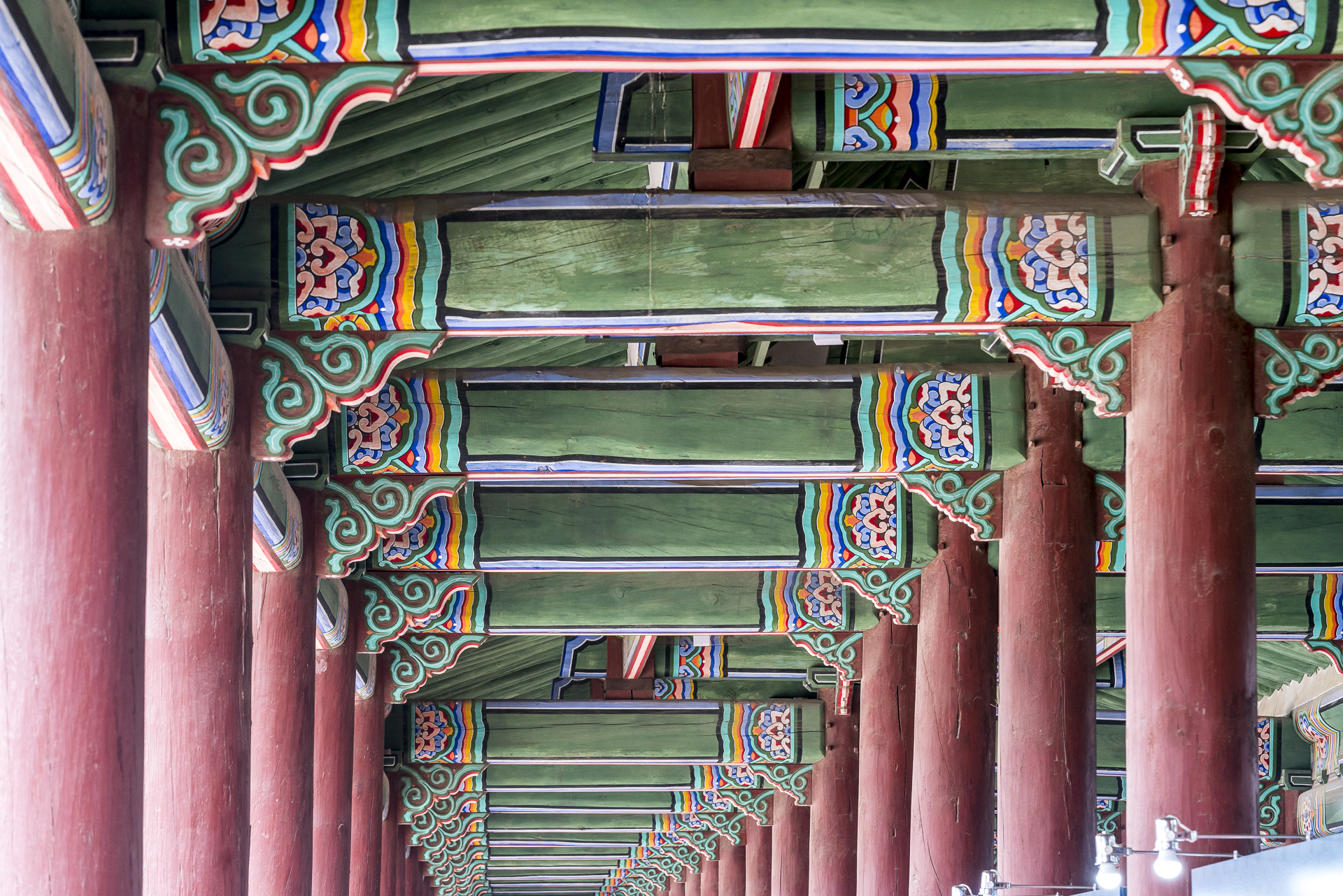
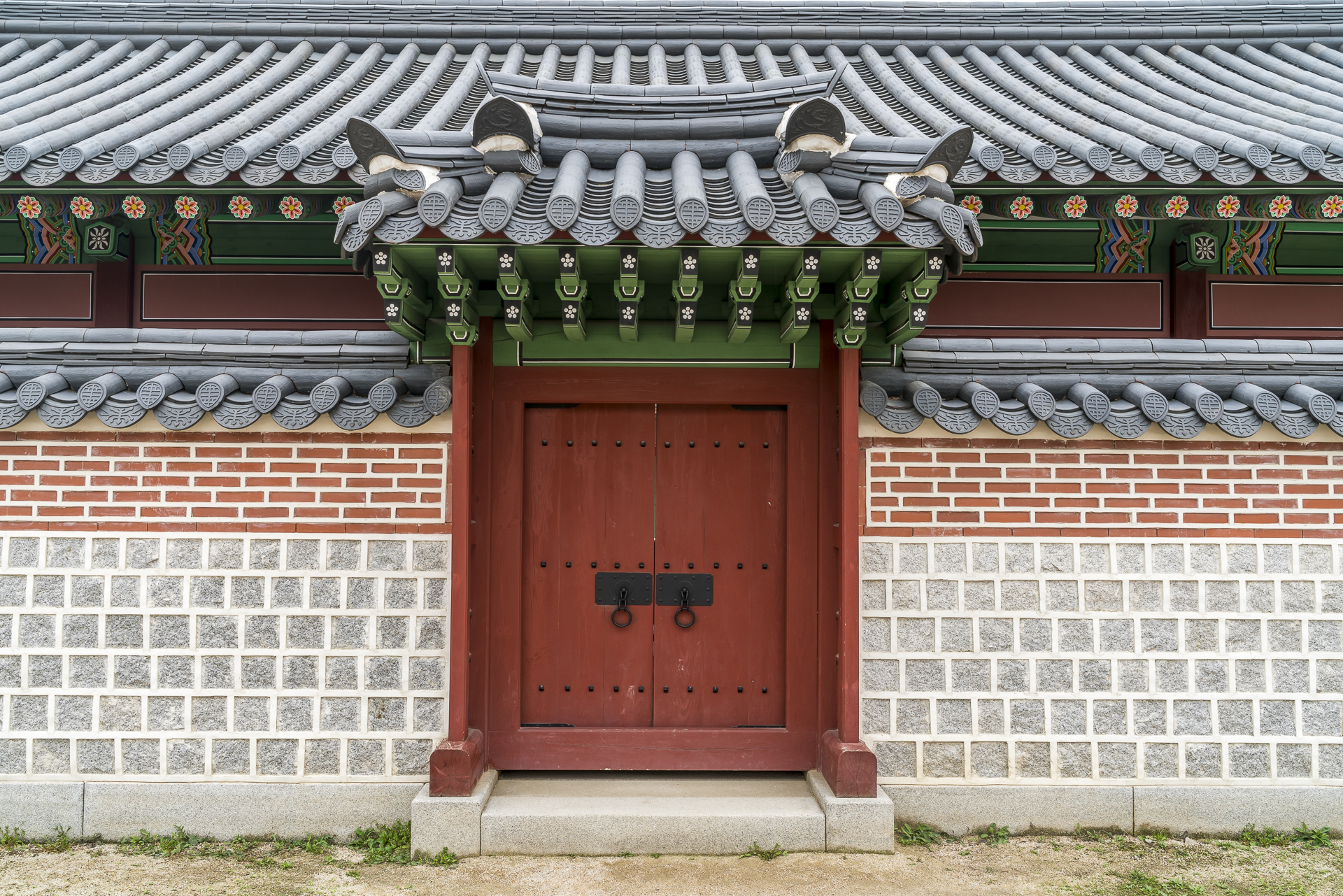
As soon as we have completed our tour, the rain sets in. Time to take care of a metro and bus ticket. The so-called Tmoney card is sold in the 7-Eleven shops (2,500 won card fee). It can be used for all metros and buses in South Korea. Mega practical! The bus connections in Seoul are also phenomenal. We use the route planner of Google Maps for this and it almost always spits on us a suitable bus connection from our location to the desired destination. Only the footpaths in South Korea can not be displayed and calculated correctly. We take the bus from the Gyeongbokgung Palace complex to the Samsung Museum of Art (Leeum). The museum is divided into two parts. One part is dedicated to traditional Korean art and the other part focuses on modern works of art. My conclusion is mixed: architecturally an interesting building, but the exhibition (especially part 2 with exhibits of modern art) did not convince me. The Leeum is just around the corner from the popular pub district of Itaewon. There are several good restaurant options here, but my favorite is Restaurant Parc, where we enjoyed a phenomenal Korean lunch.
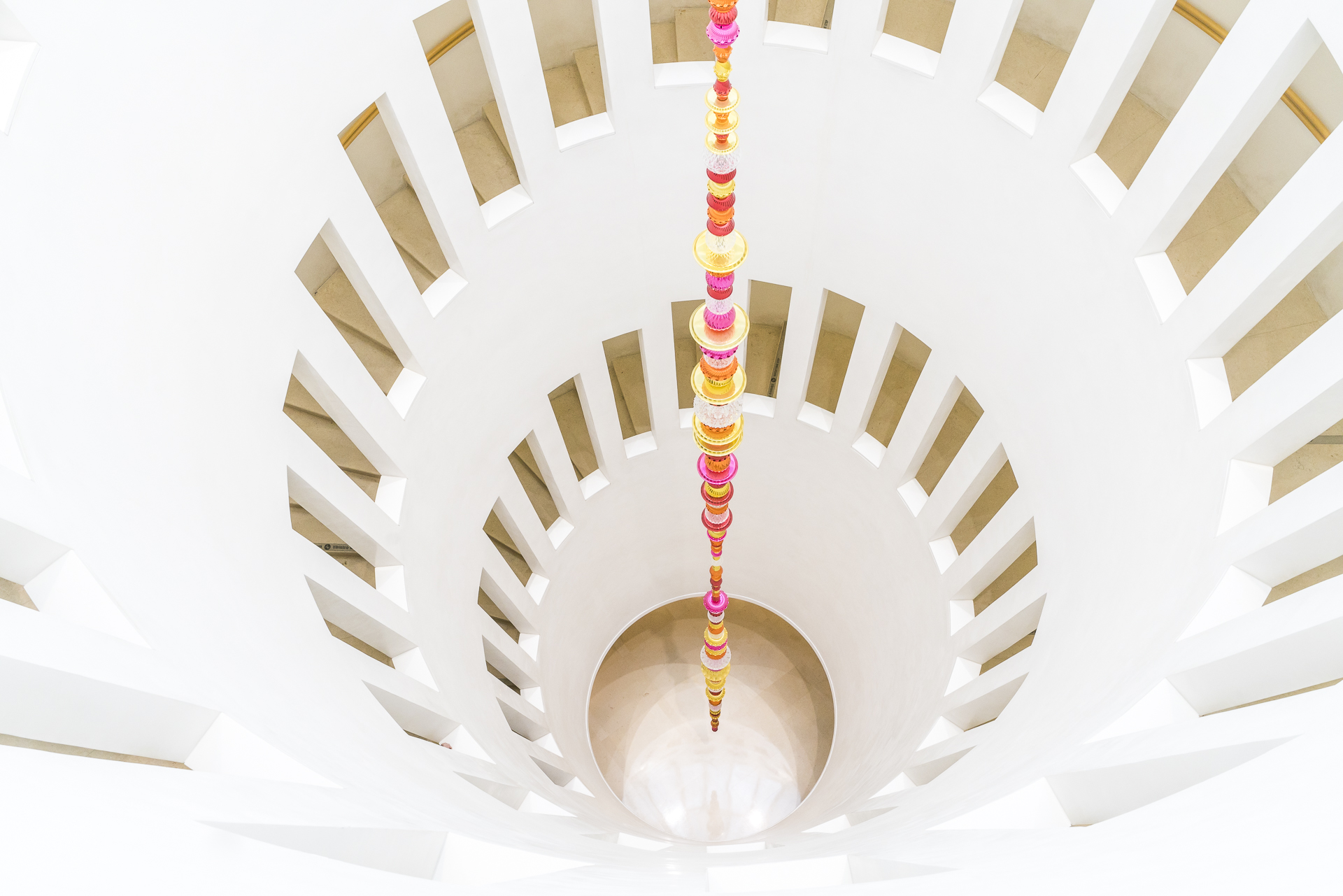
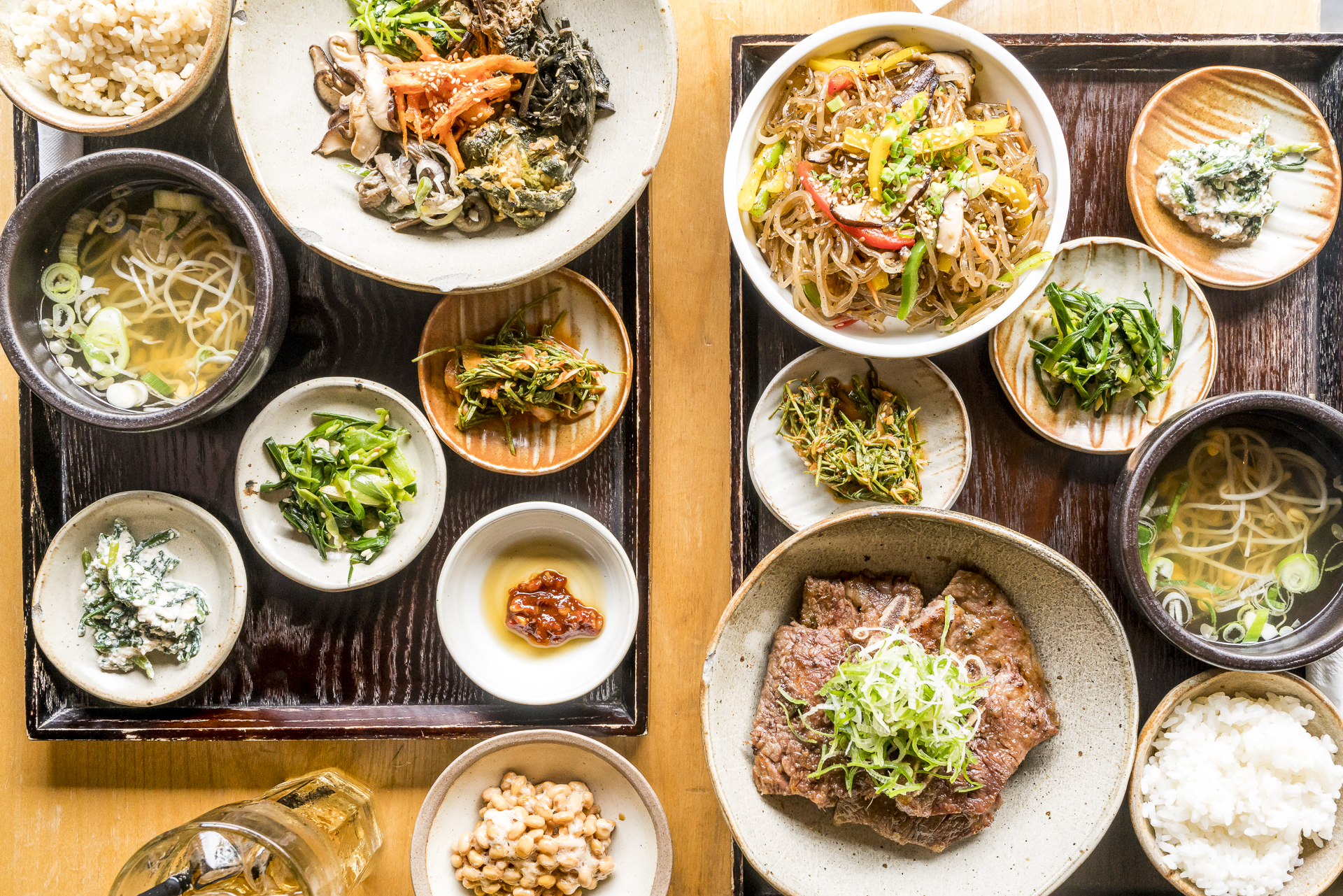
On the way back from Itaewon to our hotel, we take a look at the Dongdaemun Design Plaza (DDP). The impressive building was designed by Zaha Hadid in collaboration with the South Korean architectural firm Samoo. The building houses various exhibition and conference rooms as well as a design lab and a design market. At the end of the day, we dedicate ourselves once again to traditional Seoul and look for a place at the bar in the hidden Bukchon Son Mandu. Very fine Korean dumplings (mandu) are served here.
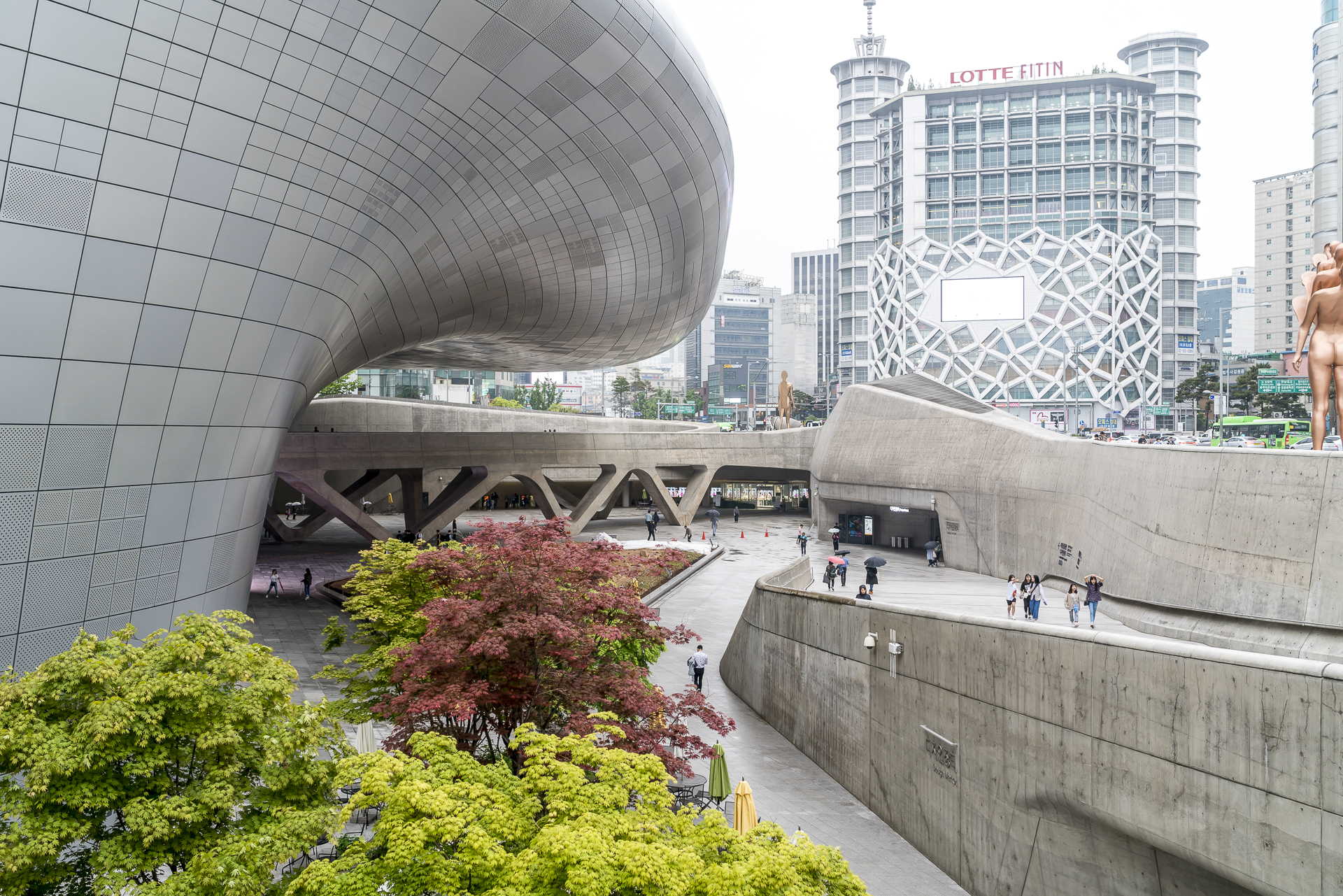
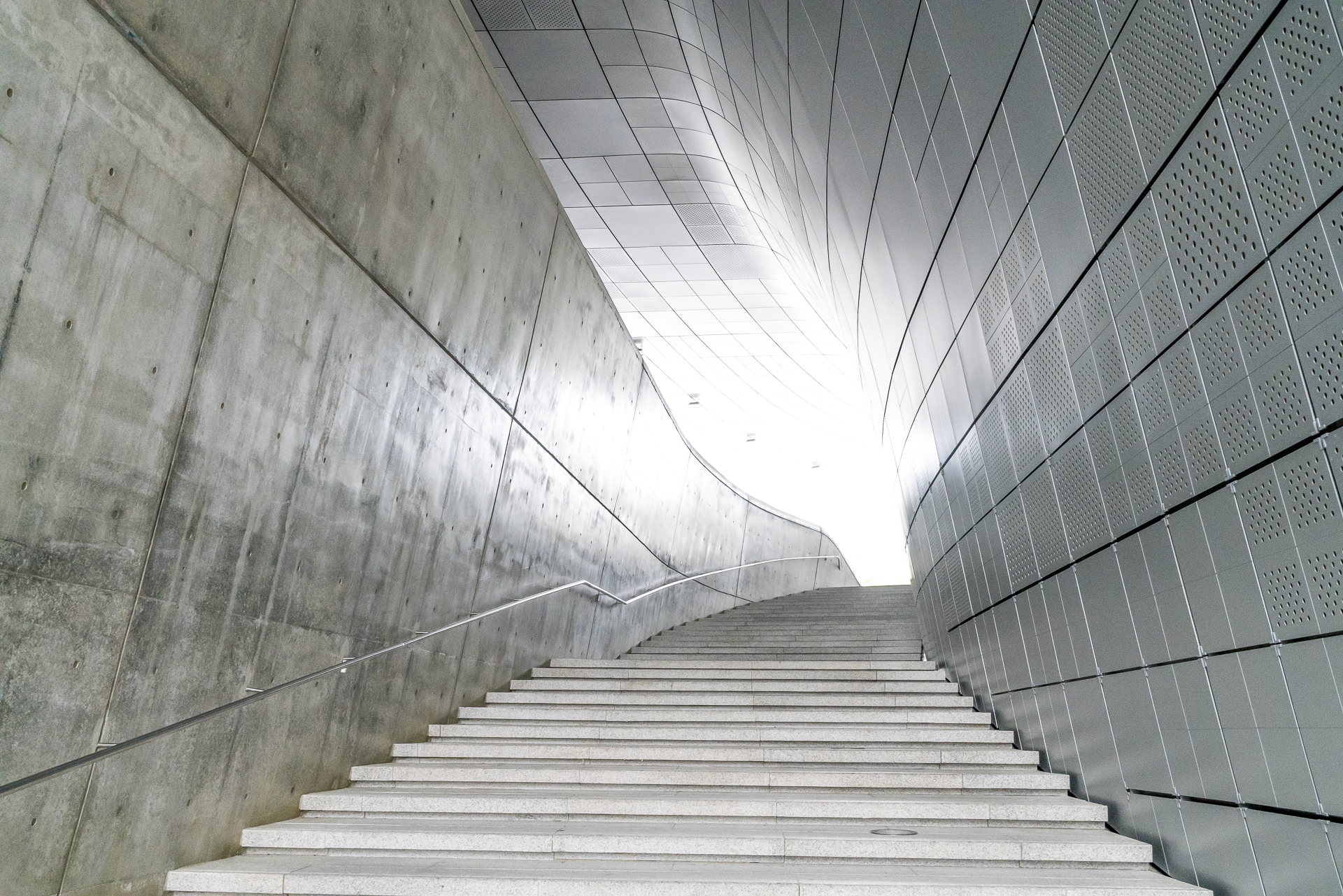
On our third day in Seoul, we end up in the “Common Ground” in search of the morning coffee and feel transported to Zurich West. With shipping containers, an oversized pop-up store was created here, where you can find local brands. Right next to it are various food trucks. However, we already have another restaurant in mind and make our way there just in time for the lunch opening time. Since we didn’t make a reservation in advance, we want to show up early. The plan works. In the Mingles restaurant, all the tables are already reserved, but we get a place at the counter. The Michelin-starred restaurant combines European and Korean influences in its cuisine, creating interesting new flavors. The 7-course lunch menu costs 75,000 won and tastes great. I also like both the ambience and the attentive service. A highly praised alternative in the immediate vicinity is the Jungsik Bar, which is already fully booked during our stay according to my e-mail request.
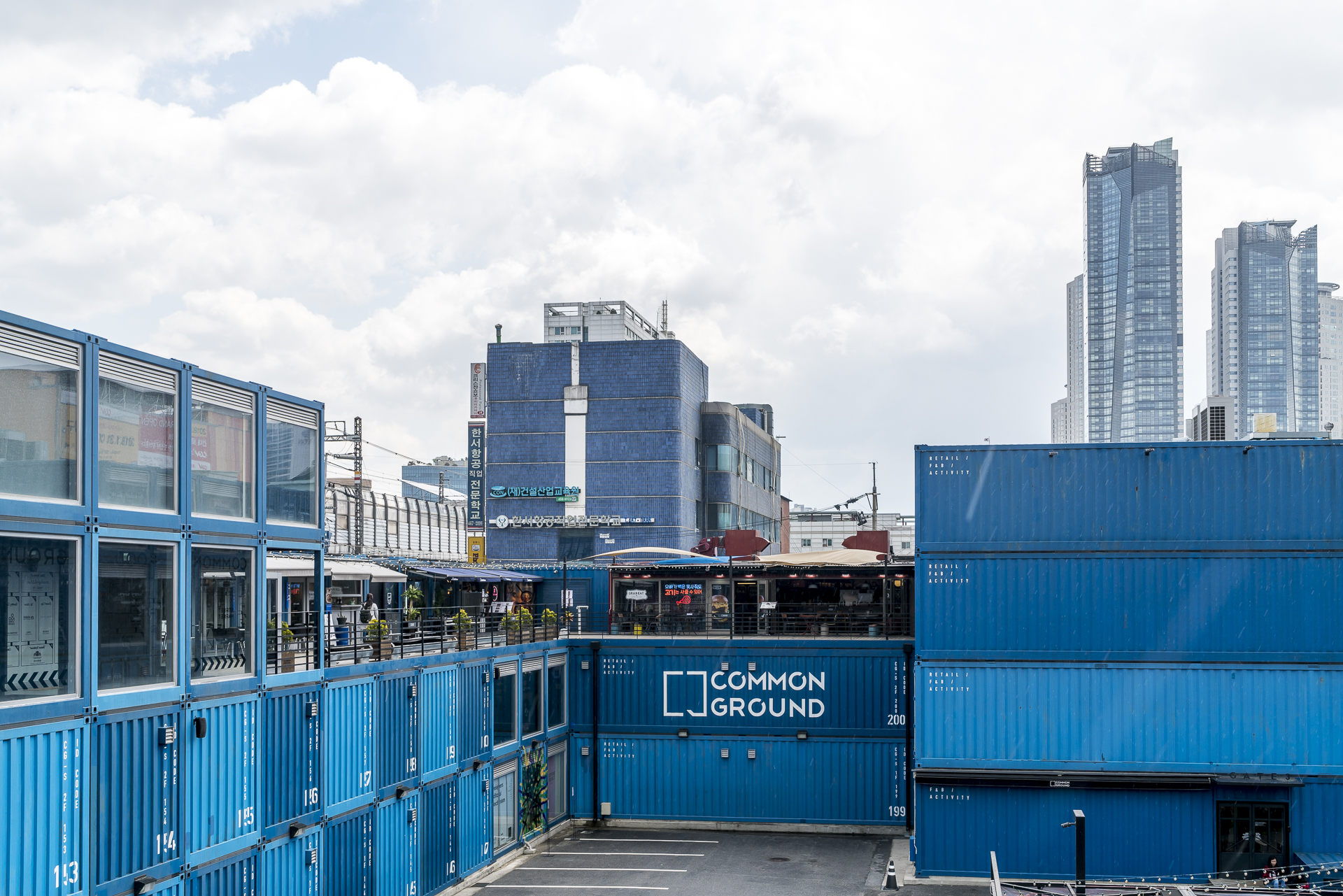
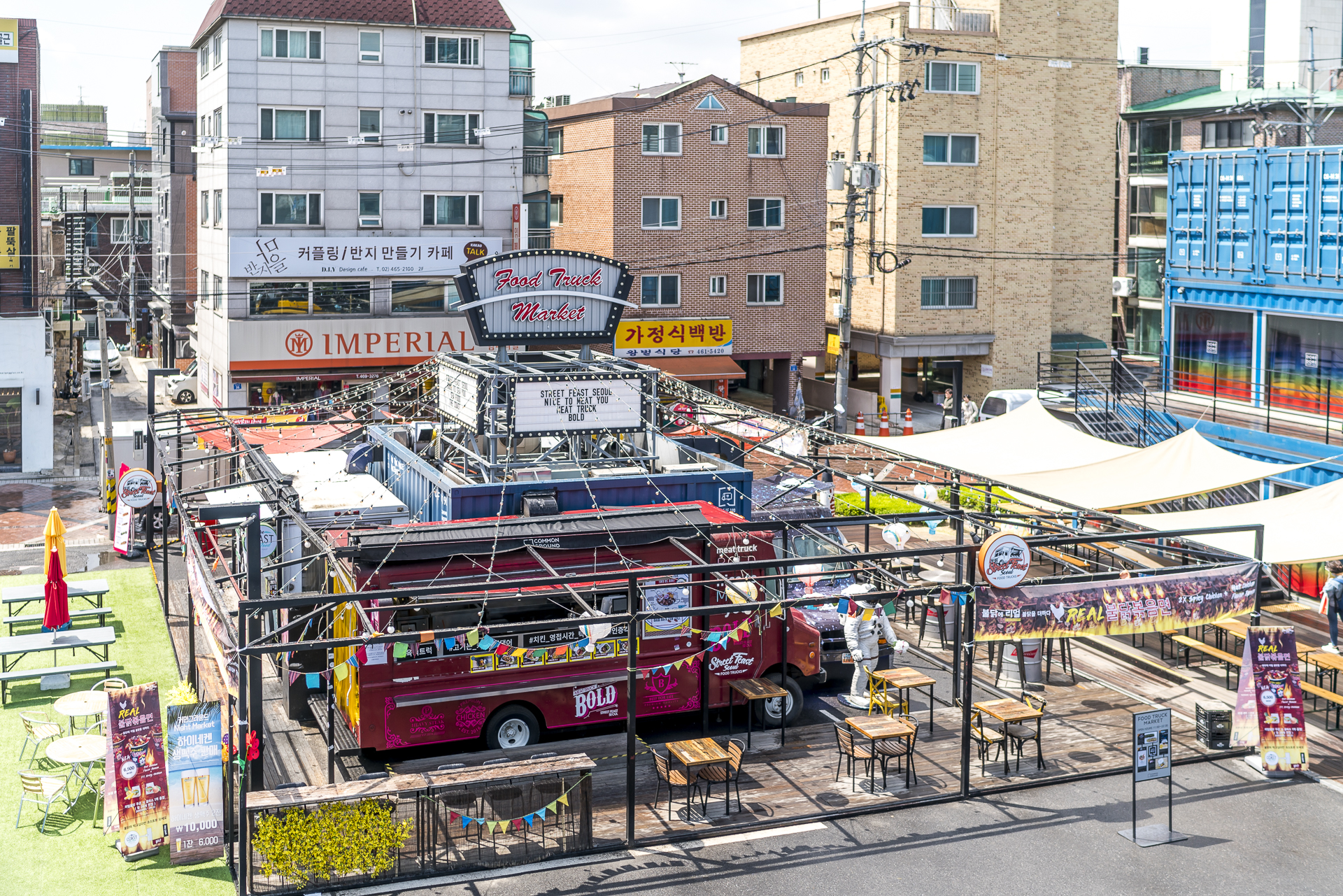
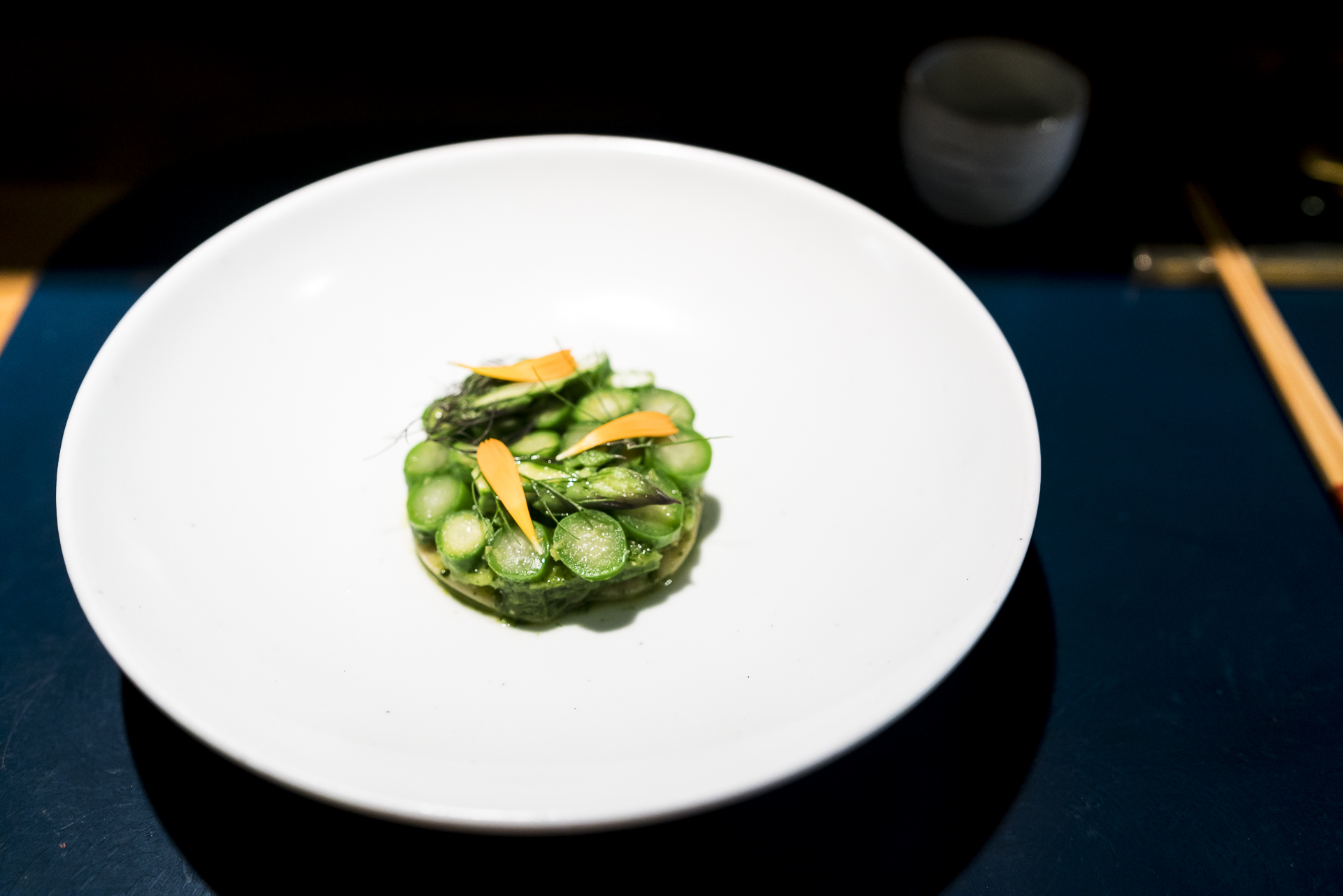
Since the rain started again at noon, we head for the library integrated into the Starfield Coex Mall for a digestive break. There we sit down on a bench and watch the hustle and bustle for a while. Seoul is totally playful when it comes to architecture, which is also evident at our last stop of the day. In the Mecenatpolis Mall not far from the Hapjeong Station, you will not only find extremely fine cake in the Caravan 2.0, but also great photo opportunities when looking up.

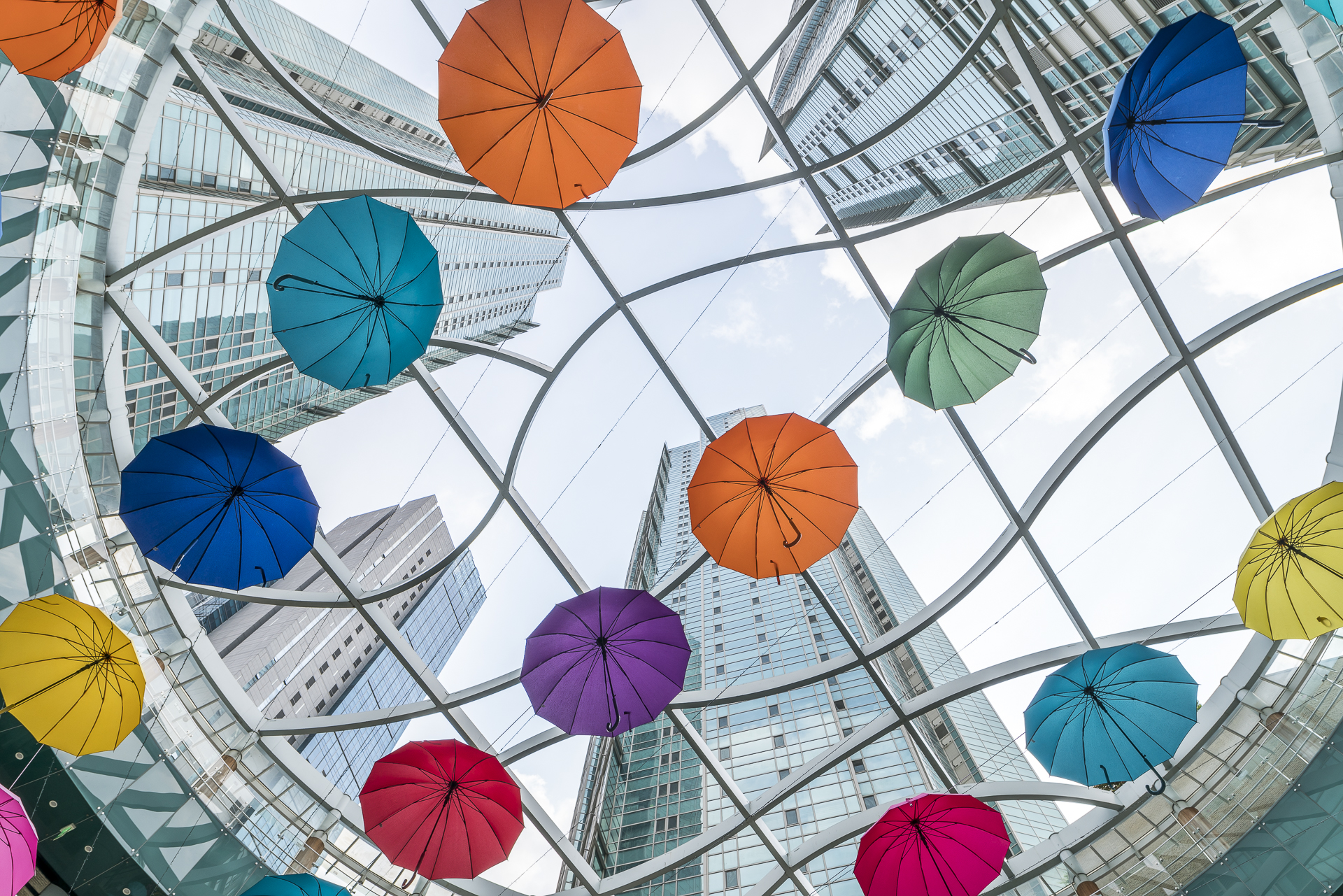
Gyeongju Sightseeing Stronghold
After three varied days in Seoul, we travel south to Gyeongju today. I had bought the train tickets for the Korean express train KTX two days earlier directly at the counter of Seoul station. Since we are at the station early, I use the waiting time for the train to visit the South Korean version of the “High Line”. In 2017, the pedestrian passage “Seoullo 7017” was inaugurated on a former elevated road. I was interested in the design of the facility because an employee of the Danish office MVRDV, which was in charge of the project, attended a summer school on urban design in London with me. In my opinion, Seoullo can’t quite keep up with the High Line, but the result of the redesign is definitely an attractively designed pedestrian crossing.
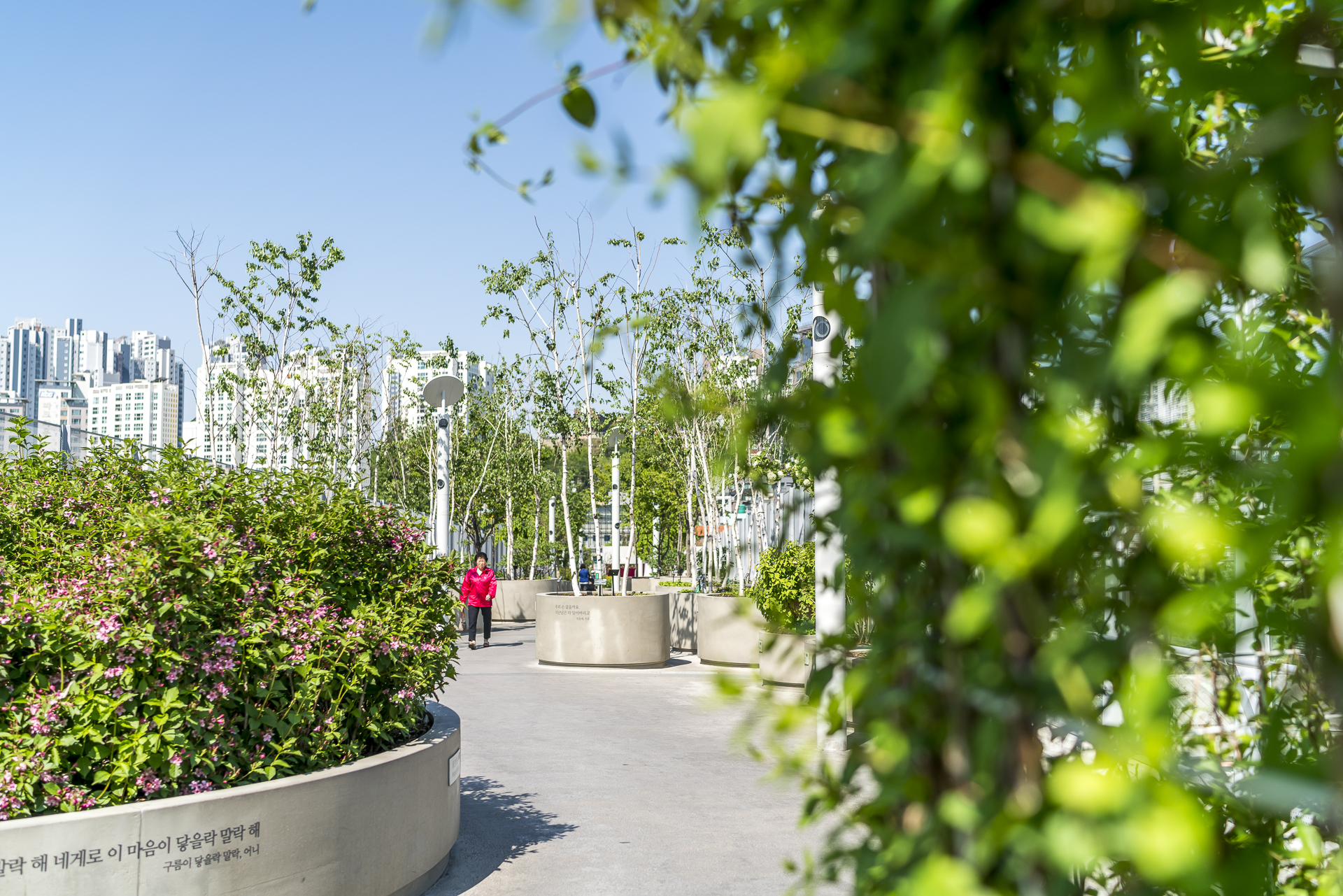
We buy a pack of fresh dumplings at the train station as travel provisions and then look for the carriage with our reserved seats. The Seoul-Singyeongju ticket costs 49,300 won per person. Unlike the Japanese Shinkansen, here we have free wifi. On the other hand, the seat pitch is smaller and our seat neighbors are much louder. After a good 2.5 hours of driving, we reach the express train station outside Gyeongju and bridge the remaining distance to our accommodation in the city center with the local bus. This works smoothly thanks to the instructions of our accommodation (Pension Siwoowadang) – we would not have found this bus connection in the Google route planner. We spend the night in Gyeongju in a small bed and breakfast, which is within walking distance of the large parks with all the sights and is kept in traditional Koranic style.
We use the remaining time until dark to visit the Daereungwon burial mounds from the Silla period. Not far from the park is the Gyori Gimbap Restaurant, which is known for its gimbaps (a Korean specialty that is reminiscent of maki in shape). Very tasty – and contrary to many online comments, our timing is so good that we don’t have to queue up long. Afterwards we marvel at the illuminated Woljeong Bridge and the Wolji Pond. Both beautiful blue-hour photo subjects. Unfortunately, we reach the Wolji pond a bit too late and the lighting is also a bit glaring, but still very nice in the dark (during the day the facility gives less).
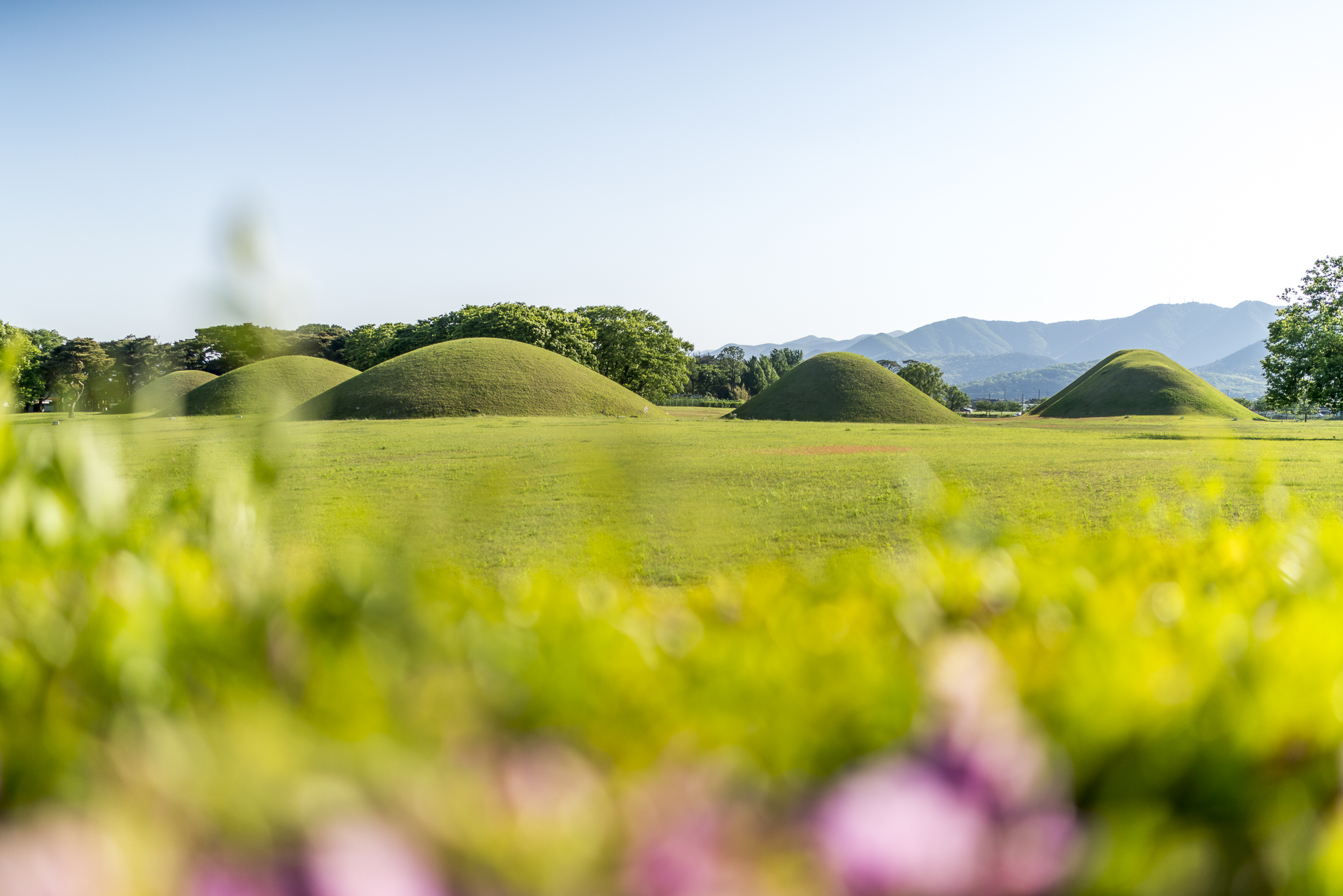
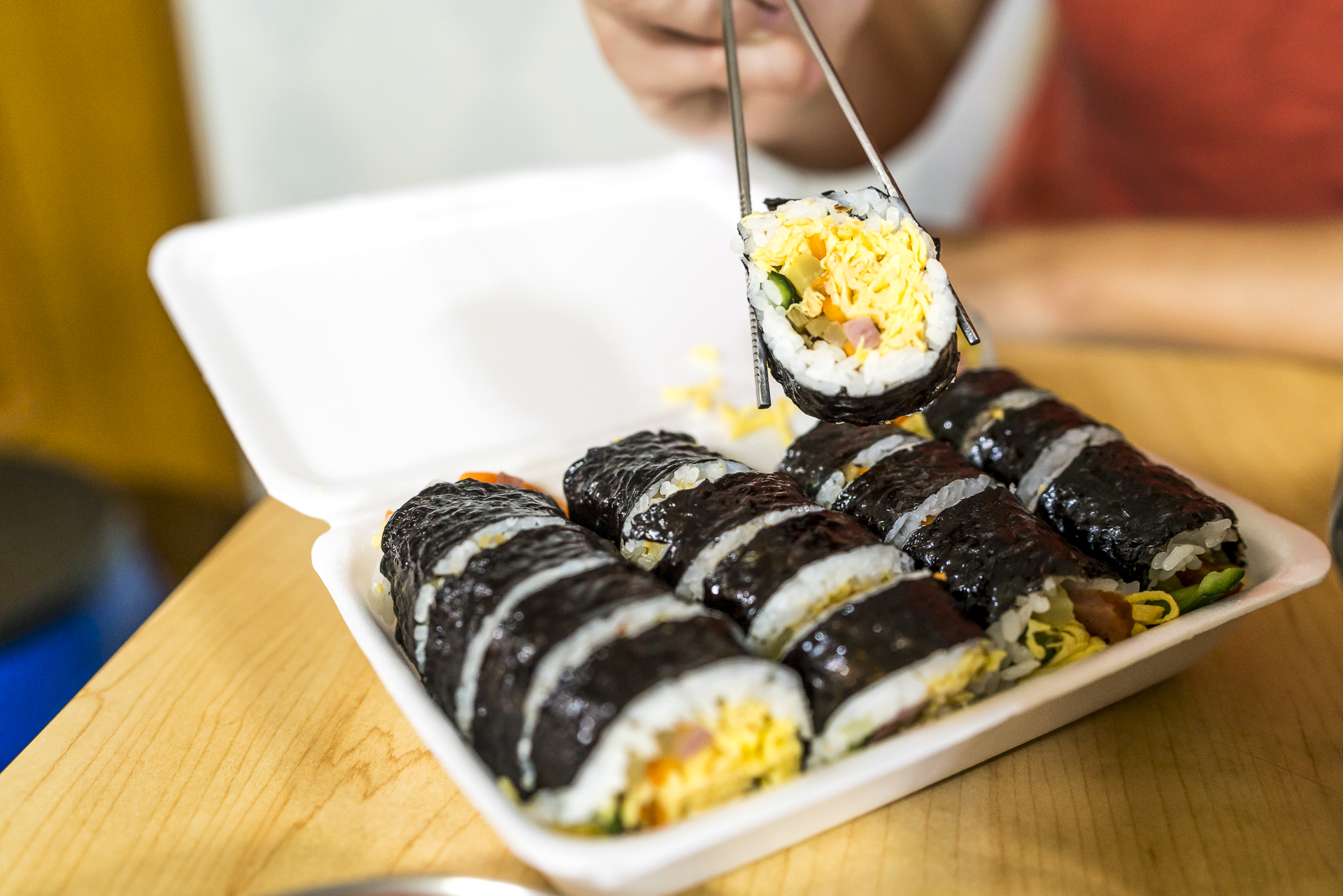
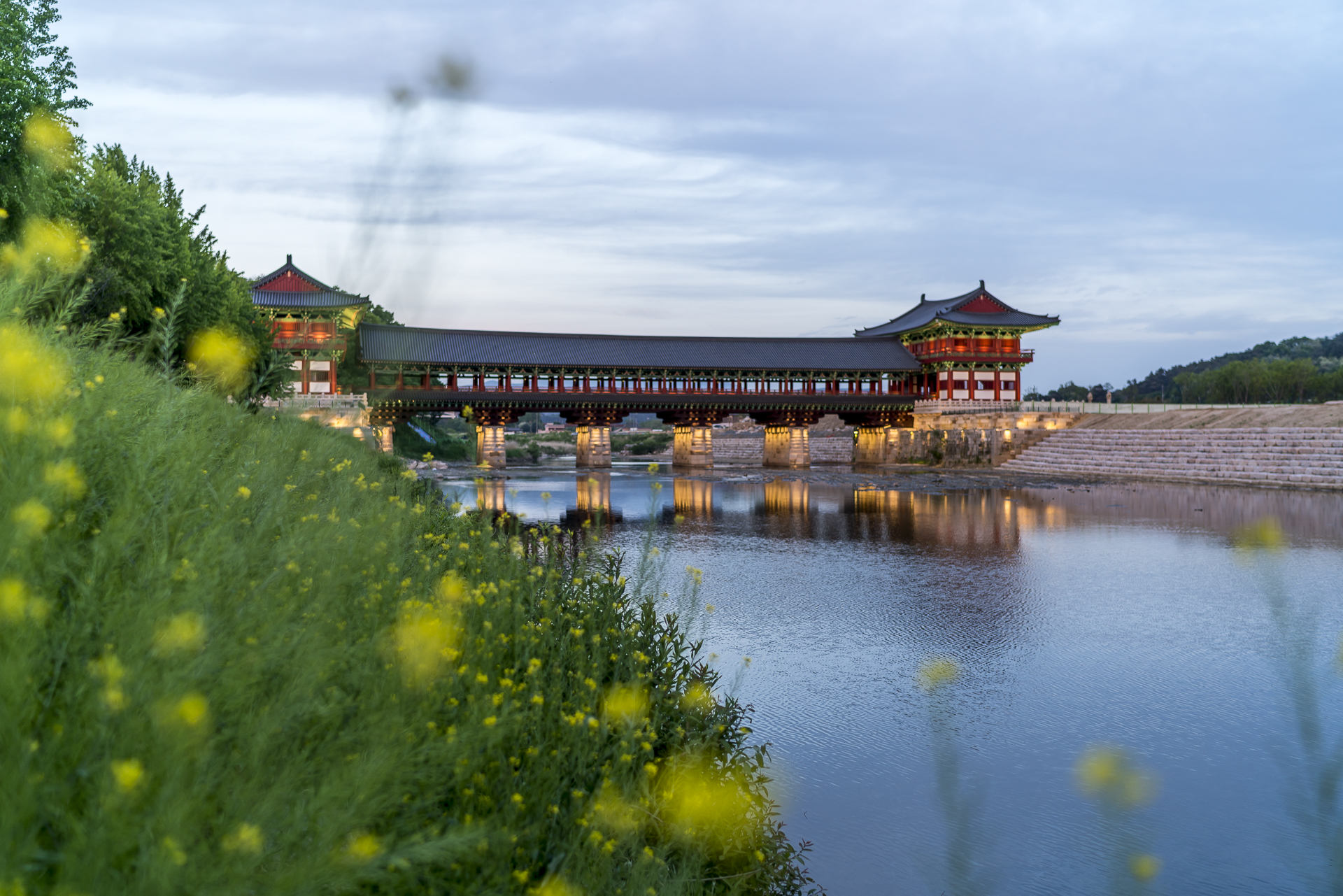
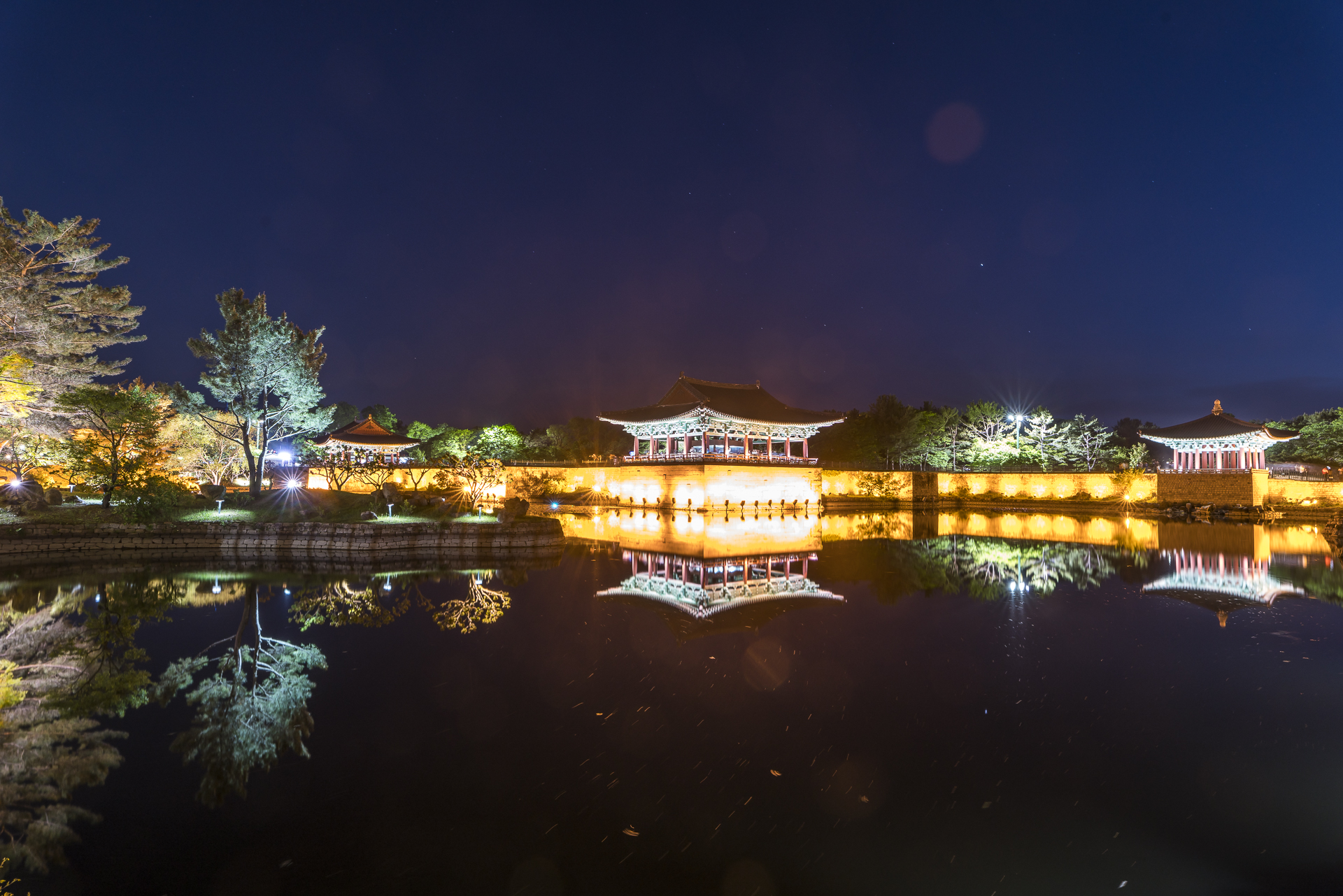
Day 2 in Gyeongju starts with a fine Korean breakfast at our Bed & Breakfast. The owners can only speak a few words of English, but communicate with us via Google Translate. Today we visit two UNESCO World Heritage Sites a few kilometers outside of Gyeongju; the Bulguksa Buddhist Temple and the Seokguram Grotto. Buses Nos. 10 and 11 run the route at regular intervals (approximately every 10-15 minutes) and the journey to Bulguksa Temple takes about 25 minutes. We catch a good time to visit temples. At the beginning of May, they are beautifully decorated for the Korean holiday “Buddha’s Birthday”. To get to Seokguram Grotto, we change to bus No. 12 after visiting the Bulguksa Temple. Unfortunately it is a bit hazy on this day, otherwise there is a beautiful panoramic view from the Seokguram Grotto to the sea.
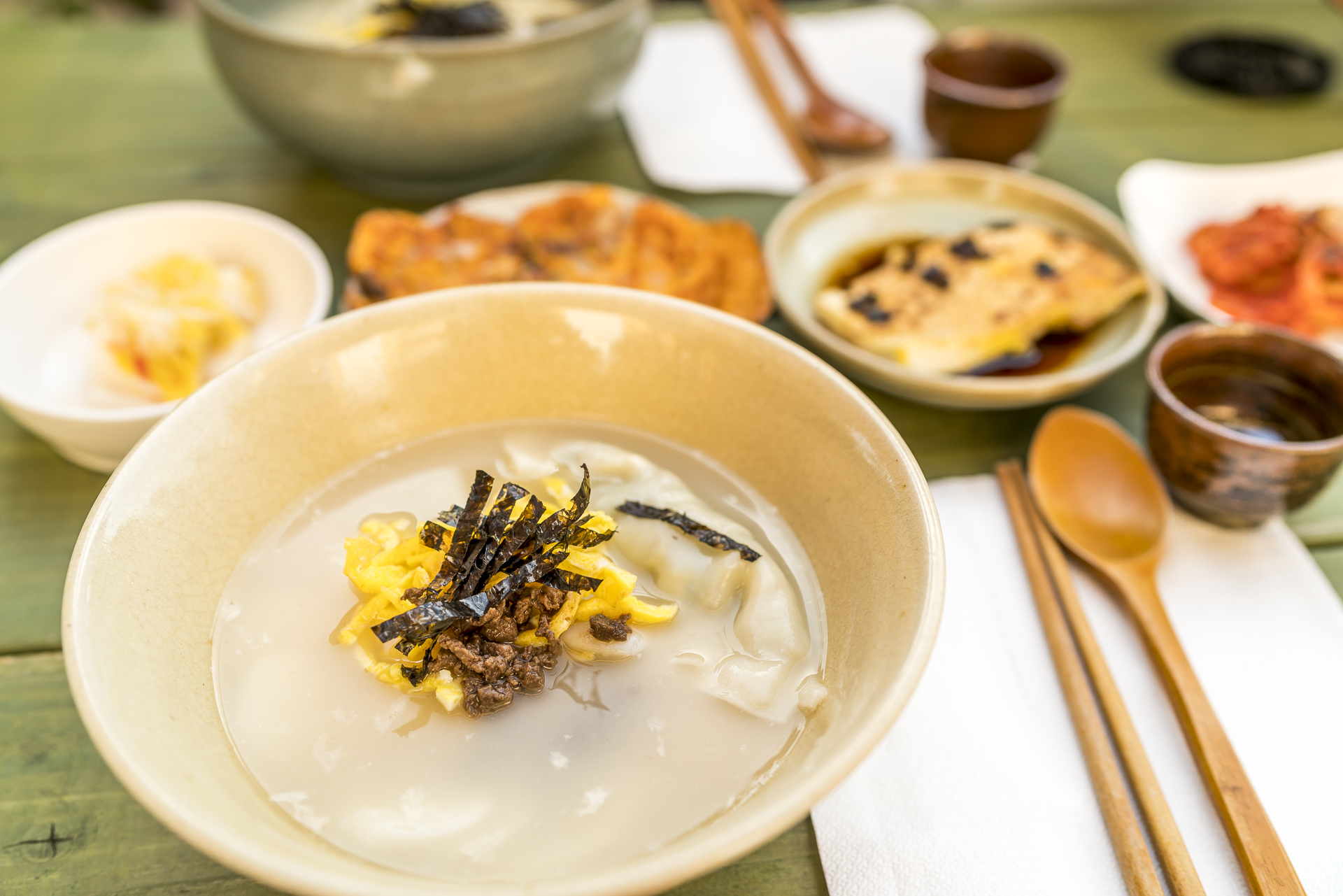
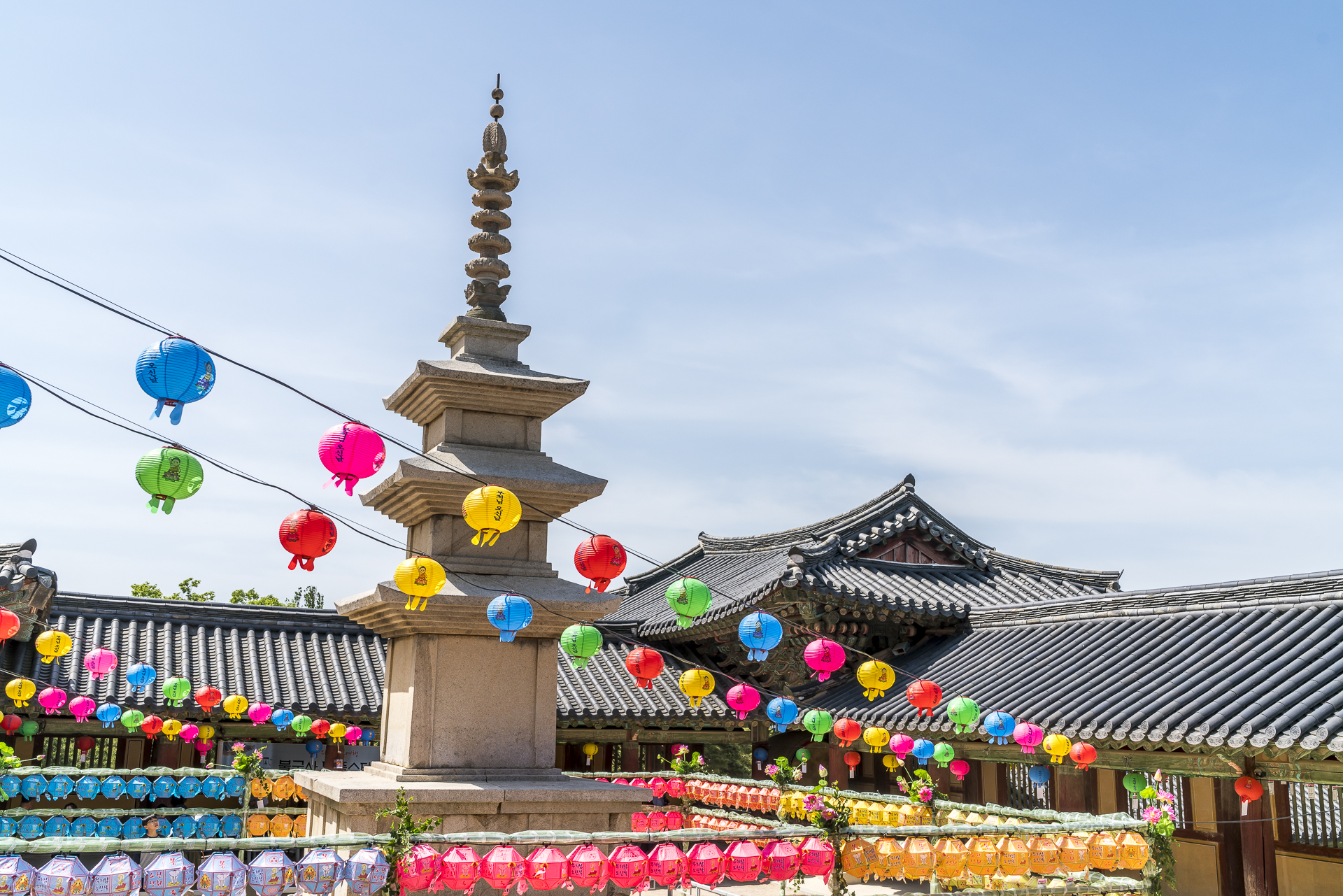
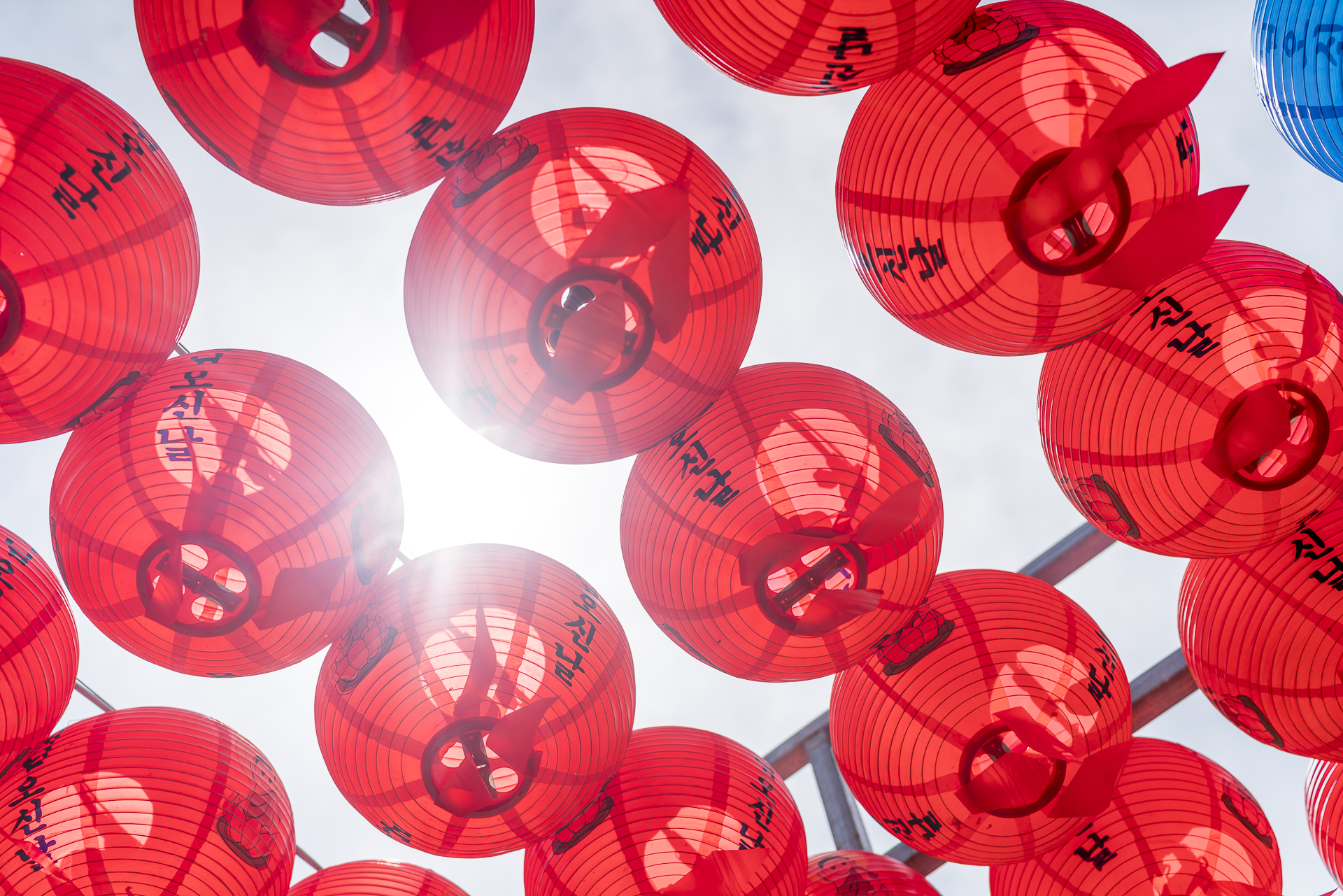
On the way back we actually want to make a stop at Bomun Lake, but stupidly catch bus no. 10 instead of bus no. 11. Bus no. 10 passes Bomun Lake on the way there – bus no. 11 on the way back. Instead of a hike around the lake, we stop in Gyeongju at Murgur Burger and eat a delicious burger. Afterwards, the evening sun lures us again into the extensive park around the ancient observatory Cheomseongda from the Silla period and we walk to the Woljeong Bridge, which we have already visited the day before. A really nice day!
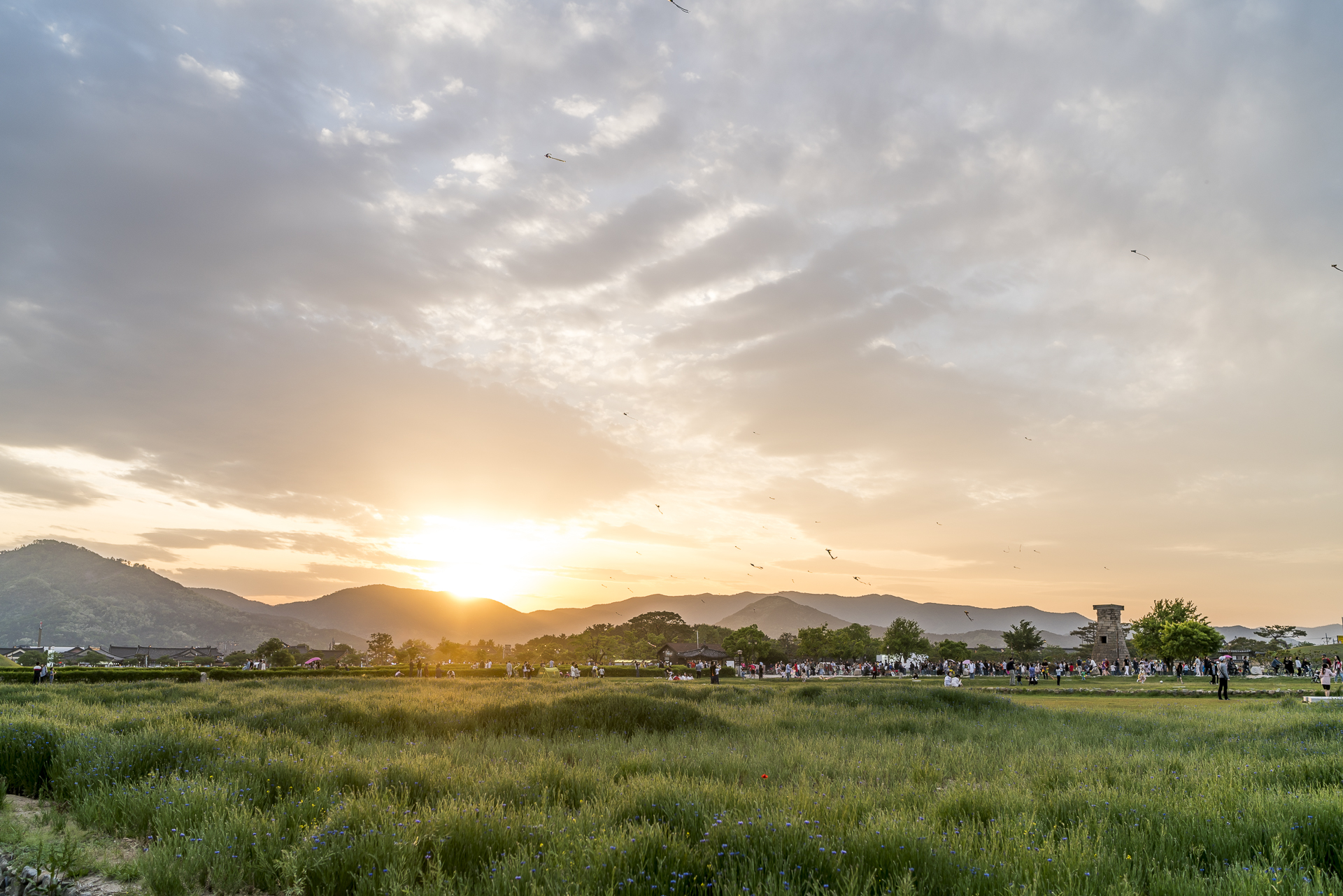
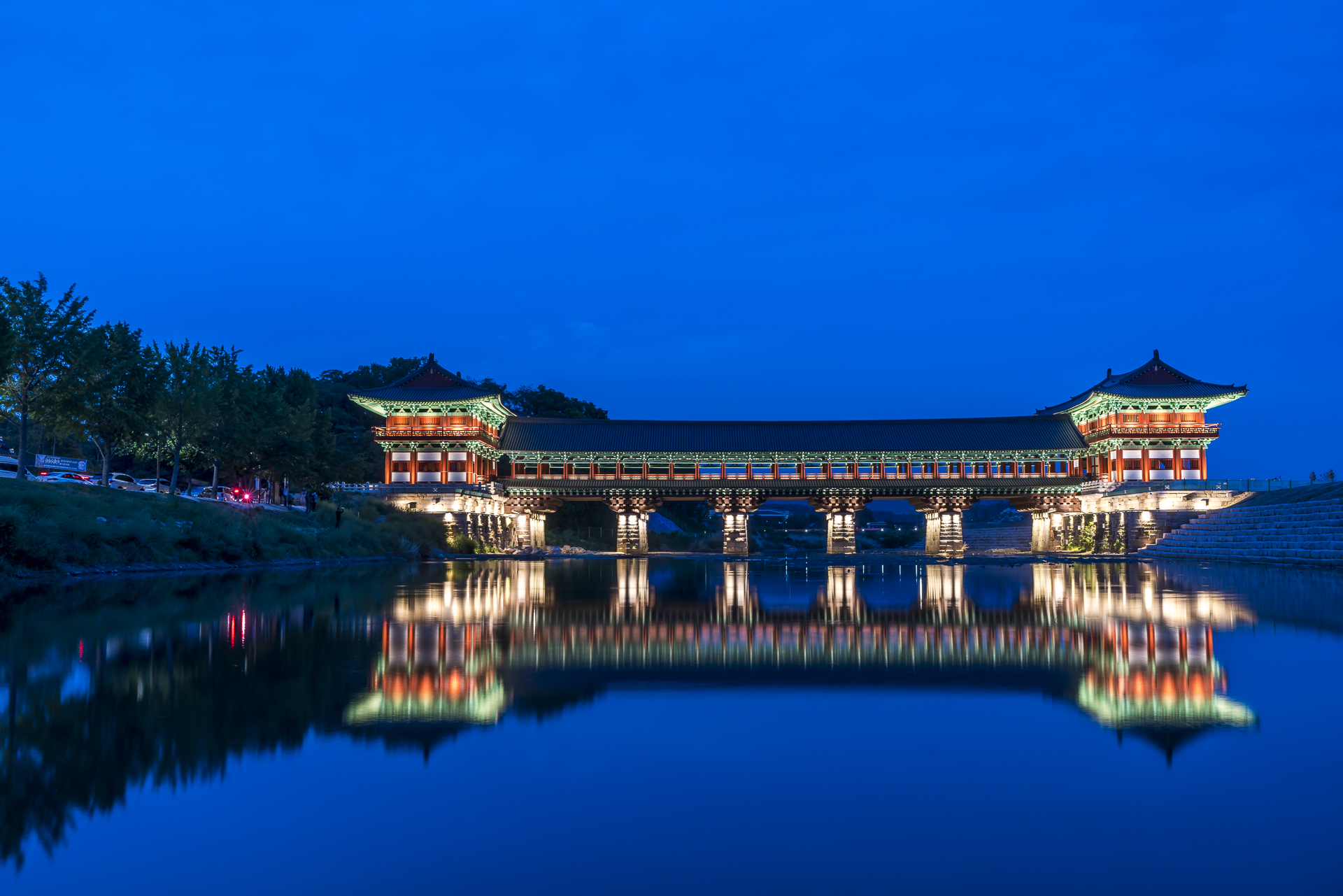
Flying visit to colorful Busan
To get from Gyeongju to Busan, there are several travel options by express train, slow train, and express bus. The easiest option seems to us to be the express bus. The express buses all depart from the express bus terminal near the Taejong-ro/Gangbyeon-ro intersection. Our B&B host couple kindly offers to chauffeur us by car to the express bus terminal. The Google route planner no longer shows the bus connections as reliably as in Seoul. However, we are lucky that an express bus leaves just ten minutes after our arrival (the route is served approximately every two hours) and tickets (4300 won) are still available. After a 50-minute drive, we arrive at Busan’s Central Bus Terminal, which is located on the outskirts of the city with direct access to Metro Line 1. Our accommodation – the TraveLight Hostel – is also located in close proximity to a stop on metro line 1, which is convenient.
After the sunny day in Gyeongju, it rains again in torrents and at the sight of the soaking wet sidewalks we lose the desire to be outside. Actually, we had planned a trip to the coast. Busan offers some beautiful spots such as the Taejongdae Park, the Oryukdo Skywalk or the temple complex Haedong Yonggungsa, which is located directly on the sea. In rainy weather, however, these are not attractive excursion destinations. And so we spend the first day in the “F1963“. The former wire factory has been converted into an arts and culture centre with a bookstore, a huge Terarosa Coffee and art exhibition space. In addition to the coffee shop, there are also two restaurants in the building. We try the traditional Korean rice wine makgeolli at the Boksonndoga restaurant, which at first glance is reminiscent of milk in terms of color and consistency, and order a very tasty bulgogi to go with it. The Boksonndoga would theoretically also have a tasting menu on offer, but you have to book at least one day in advance.
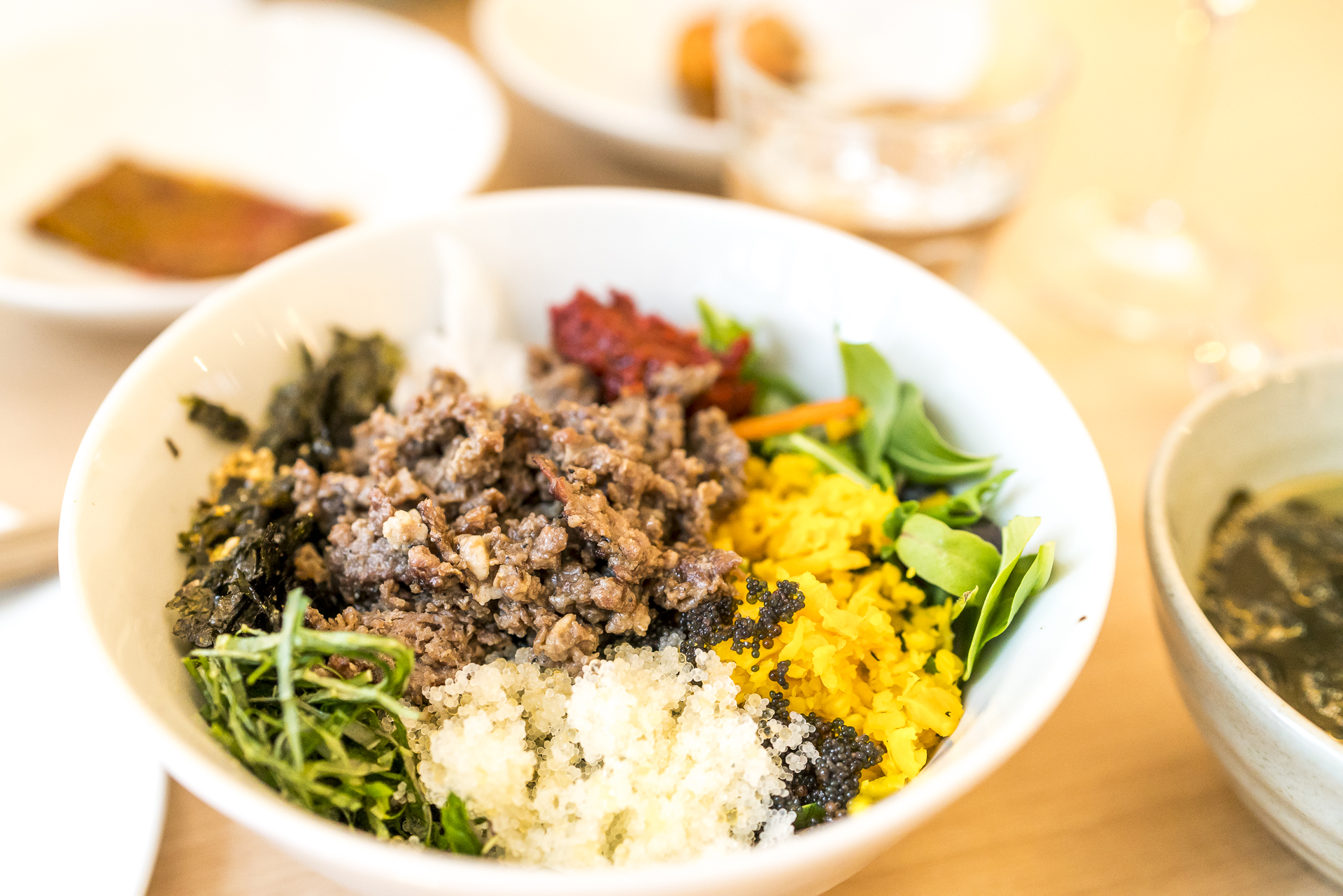
The next day, the weather slowly improves. We would actually be prepared for the rain with an umbrella and rain jacket. What we are missing are rain boots and they would be essential in Korea. As soon as the rain stops, we take the metro to the big Jagalchi fish market at the port of Busan. From here, a small neighborhood bus goes up to Gamcheon Culture Village. The settlement, located on the steep slope, was built during the Korean War, where Busan was the destination of numerous war refugees, and developed into a slum. In 2009, the residents, together with artists and local politicians, launched an initiative to renew and beautify Gamcheon – with success. The transformation from a dilapidated poor settlement to a brightly painted hillside village not only increased the quality of life of the local population, but also made Gamcheon a tourist attraction. We buy an overview map for 2,000 won – the money goes towards the renovation measures – and explore Gamcheon on the path signposted for tourists, which leads in many serpentines right through the settlement. At the end of the day, we are even granted a few rays of sunshine. We satisfy our hunger just around the corner from our hostel, where there are numerous alley kitchens. During the two days, we tested the Songjeong Samdae Gukbop, where Busan’s famous meat soup with rice is served. On the other hand, we tried Korean BBQ at Noxen Drumtong Seomyeon Lotte. Both very tasty!
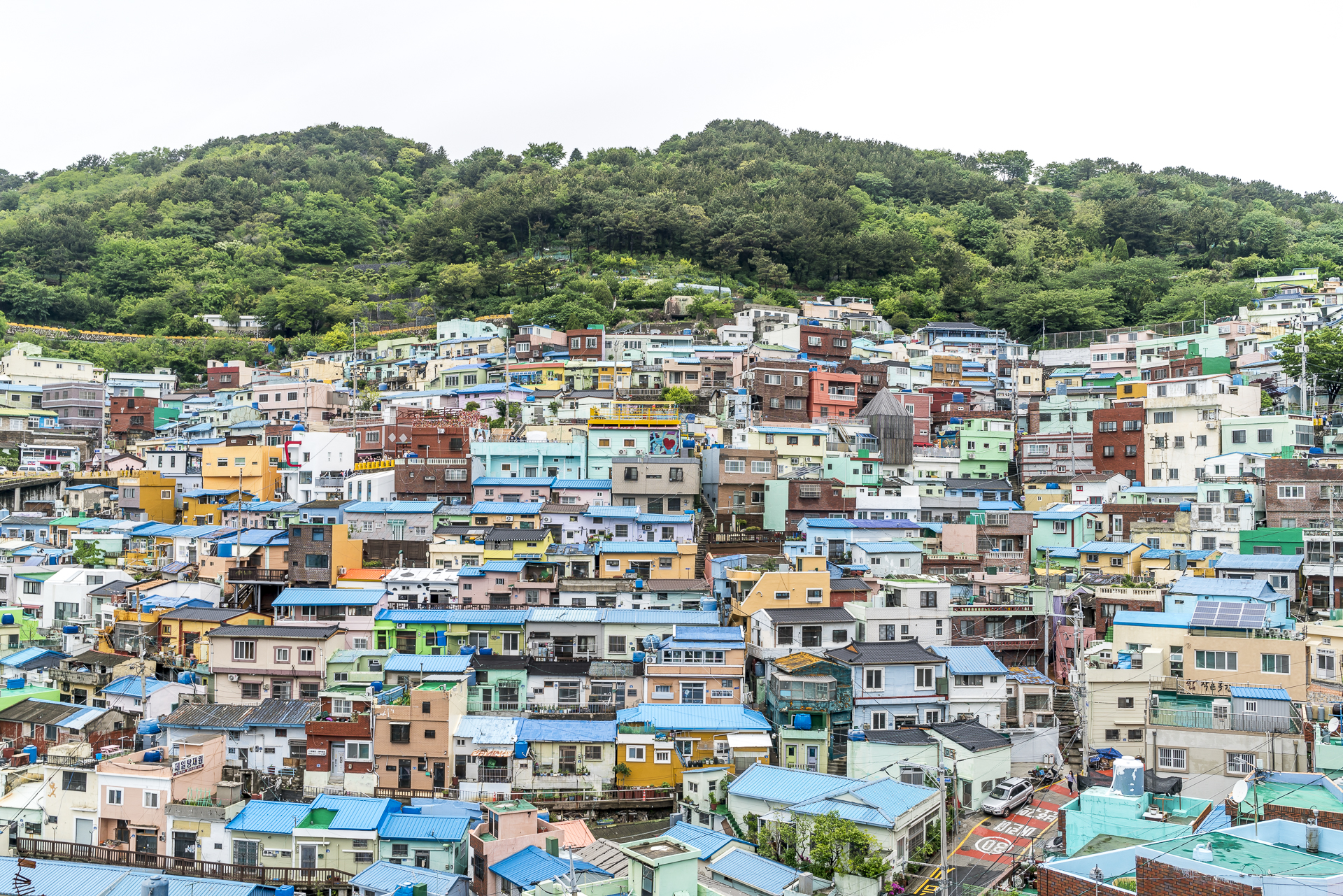
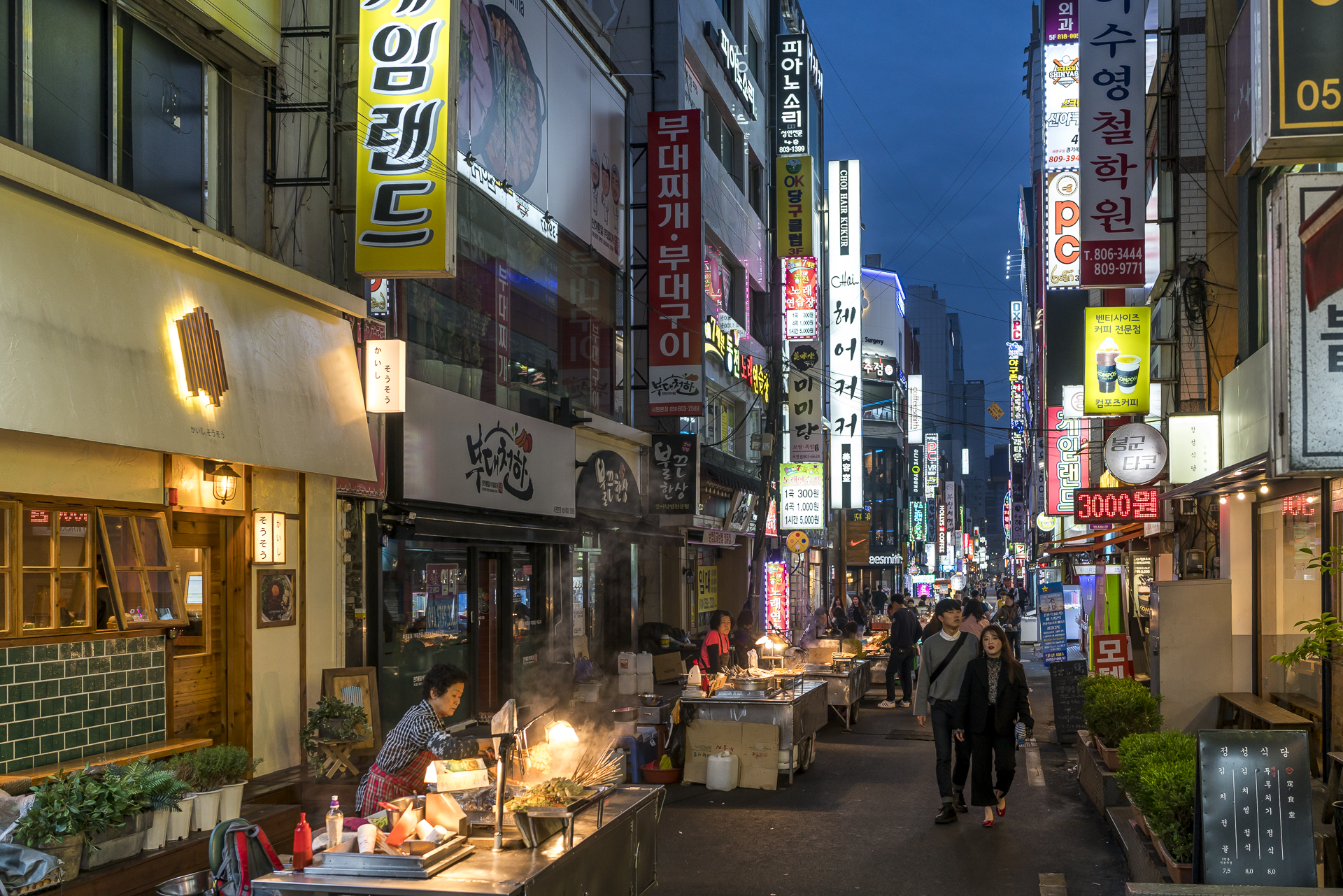
The next day, we take the KTX express train from Busan Station back to Seoul in just under three hours (ticket cost 59,600 won). That’s how fast a one-week round trip through South Korea goes by and we are thrilled! South Korea has far exceeded our expectations and we will definitely travel here again because we only saw a fraction of the country this week.
Practical travel tips for your trip through South Korea
- Seoul has two international airports, both located on the same metro line connecting to Seoul Station: Incheon and Gimpo. If you’re traveling from Europe, you’ll most likely end up in Incheon – but look carefully at your plane tickets, not that you’re heading for the wrong airport like we did. The journey time from Incheon to Seoul Station is one hour.
- The South Korean currency is called Won. 1 CHF is worth around 1080 won.
- A lot of ATMs did not accept our Maestro card (despite activation). At the airport we had to withdraw money with Visa, which is unfavorable in terms of fees. The express bus ticket from the airport to the city centre can also be paid by card.
- For the overnight stays described in the article (7 nights in a double room with bathroom) we paid a total of 565 CHF. In Seoul we had booked the overnight stay without breakfast. In Gyeongju and Busan, breakfast was included. I can highly recommend all three accommodations booked and linked in the article.
- The classic one-week South Korea round trip Seoul-Gyeongju-Busan can be easily traveled by train. We bought single tickets. Depending on the itinerary, the Korail Pass offers better value for money. We paid a total of 113,200 won per person for the Seoul-Gyeongju-Busan-Seoul route (about 106 CHF).
- To use the city buses and metro lines, it is worth buying the Tmoney (or Cashbee) card, as it is very practical to use and can be used in all cities. The card costs 2,500 won and can then be topped up flexibly at any metro station or in 7-Eleven shops. We used the map in Seoul as well as in Gyeongju and Busan. Remaining ticket amounts over 500 won will also be refunded at the end of the trip.
- The German-language page of Visit Korea offers a lot of information about the various sights. In addition to opening hours, it also describes how to get there by public transport (including bus numbers).


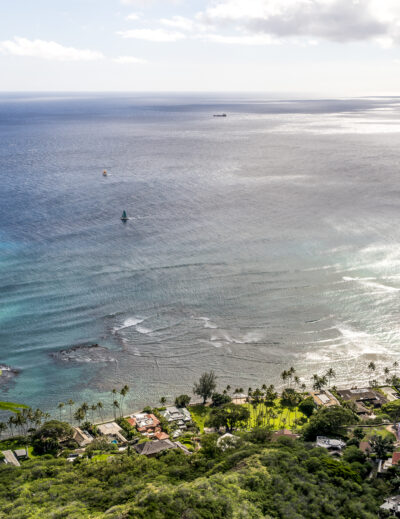

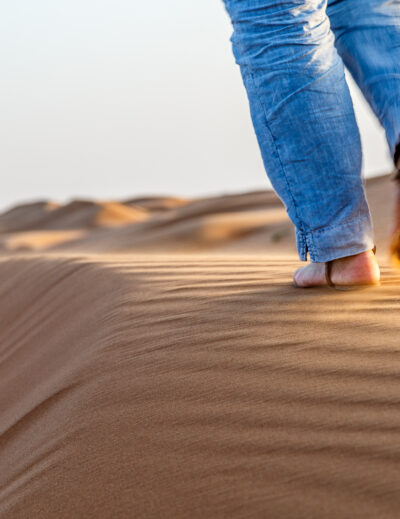
Leave a Reply